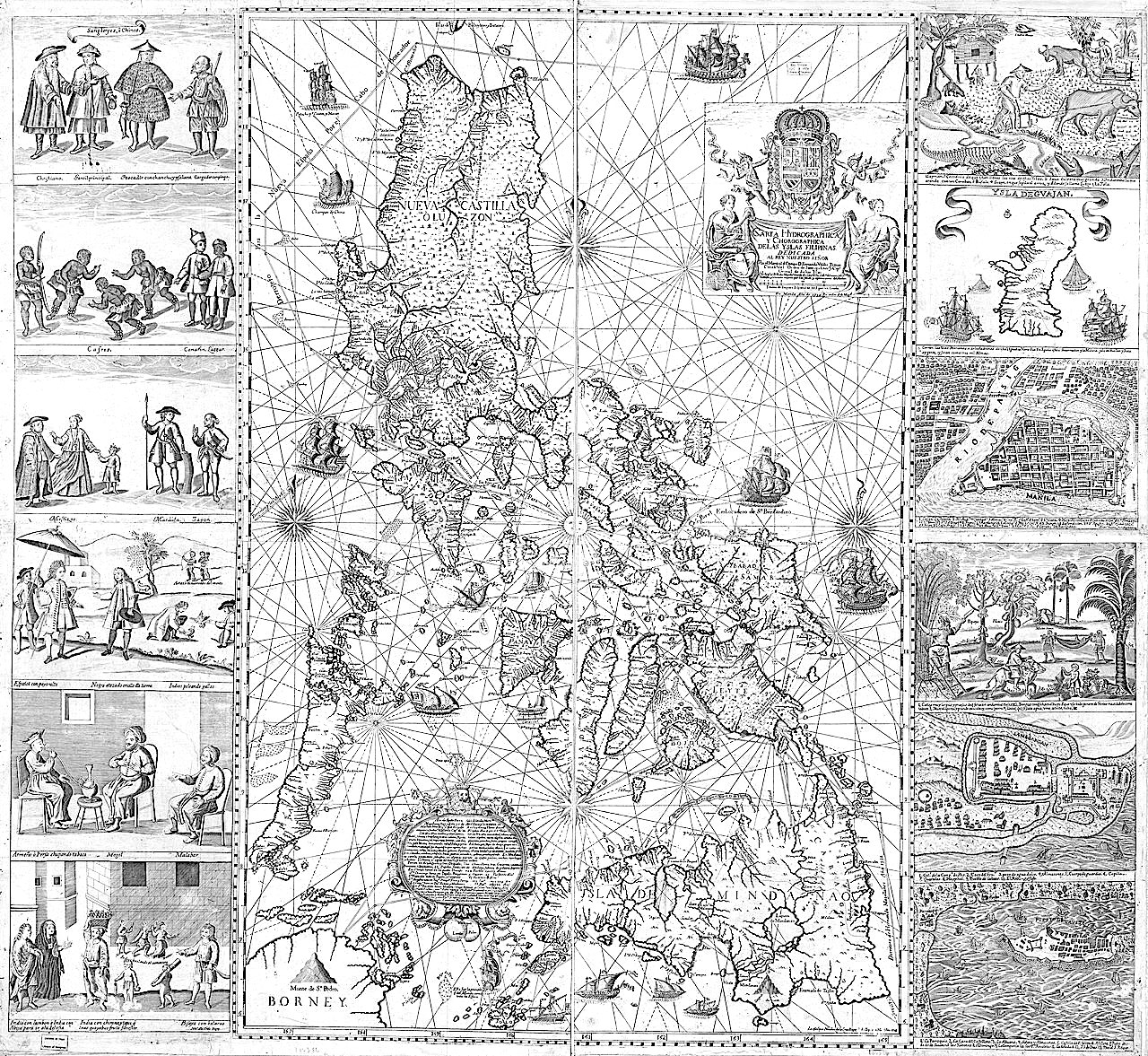
A hydrographical and chorographical chart of the Philippines, drawn by the Jesuit Father Pedro Murillo Velarde (1696-1753) and published in Manila in 1734
先スペイン期のフィリピンの歴史
History of the
Philippines before Spanish
conquest

A hydrographical and chorographical chart
of the Philippines, drawn by
the Jesuit Father Pedro Murillo Velarde (1696-1753) and published in
Manila in 1734
☆ フィリピンの歴史は、少なくとも70万9000年前にフィリピン列島で初期の人類が活動していたことから始まる。[1] 旧人類の一種であるホモ・ルソネンシスは、少なくとも13万4000年前にはルソン島に存在していた。[2][3] 現生人類としては最古のものは、パラワン島のタボン洞窟から出土した約4万7000年前のものとされている。[5] ネグリト族が先史時代のフィリピンに最初に定住した人々であった。[6] その後、オーストロアジア人、パプア人、南アジア人が続いた。[7] 紀元前3000年頃までに、現在の人口の大半を占める海洋民族であるオーストロネシア人が台湾から南下してきた。[8] 紀元前2000年頃には、この諸島は大洋を越えたフィリピンのヒスイ文化の中心地となっていた。 学者たちは一般的に、これらの民族や社会集団が最終的に、経済的専門性、社会的階層化、政治的組織化の度合いに差異のあるさまざまな集落や政治体制へと発 展したと考えている。[10] これらの集落の一部(主に主要な河川デルタに位置するもの)は、社会的に非常に複雑な規模に達しており、一部の学者は、それらは初期の国家として考慮され るべきだと考えている。[11] これには、マニラ、トンド、パンガシナン、セブ、パナイ、ボホール、ブトゥアン、コタバト、ラナオ、ザンボアンガ、スールーといった現代の人口密集地の先 行者たちも含まれる。ボホール、ブトゥアン、コタバト、ラナオ、ザンボアンガ、スールー[12] などの現代の人口密集地のほか、マイなどのいくつかの政治体(マニラの位置はミンドロ島またはラグナ島である可能性がある。[13] これらの国家はイスラム教、インド、中国などの文化の影響を受けていた。イスラム教はアラビアから伝来し、インドのヒンドゥー教・仏教[14]の宗教、言 語、文化、文学、哲学はラジェンドラ・チョーラ1世の東南アジア遠征などの遠征を通じて伝来した。[15] いくつかの国家は中国と同盟を結んだ中国化された朝貢国であった。これらの小さな海洋国家は1世紀から繁栄した。[16][17] これらの王国は、現在の中国、インド、日本、タイ、ベトナム、インドネシアと交易を行っていた。その他の集落は、より大きな国家の1つと同盟関係にある独 立したバランガイであった。これらの小国家は、明やマジャパイト、ブルネイといったより大きなアジアの帝国の一部となるか、それらの帝国の影響下に入る か、あるいはそれらに対して反旗を翻して戦争を仕掛けるかを交互に繰り返した。 ヨーロッパ人による最初の記録に残る訪問は、1521年3月17日に、現在の東サマール州グイアン市に属するホモンホン島に上陸したフェルディナンド・マ ゼランの遠征隊である。彼らはマクタン島の酋長ラプラプの軍隊との戦いに敗れ、マゼランは戦死した。[19][20][21] スペイン領フィリピンは、ヌエバ・エスパーニャの太平洋進出と、1565年2月13日にメキシコからミゲル・ロペス・デ・レガスピの遠征隊が到着したこと から始まった。彼はセブに最初の恒久的な入植地を築いた。[22] フィリピン諸島の大部分がスペインの支配下に入り、フィリピンとして知られる最初の統一された政治体制が誕生した。スペインの植民地支配により、キリスト 教、法体系、アジア最古の近代的な大学が導入された。フィリピンはメキシコを拠点とするヌエバ・エスパーニャ副王領の統治下に置かれた。その後、メキシコ の独立に伴い、植民地はスペインに直接統治されるようになった。 スペインによる統治は、米西戦争におけるスペインの敗北により、1898年に終了した。その後、フィリピンはアメリカの領土となった。アメリカ軍はエミリ オ・アギナルドが率いる革命を鎮圧した。アメリカはフィリピンを統治するために、島嶼政府を樹立した。1907年、フィリピン議会が選挙により選出され た。米国はジョーンズ法で独立を約束した。[23] 1935年、完全な独立までの10年間の暫定措置としてフィリピン自治領が樹立された。しかし、1942年の第二次世界大戦中、日本はフィリピンを占領し た。1945年、米軍が日本軍を撃破した。1946年のマニラ条約により、フィリピン共和国が独立した。
★︎先スペイン期のフィリピンの歴史▶フィリピンの歴史(スペイン支配期:1565–1898)︎▶フィリピン共和国の歴史(1899〜現在)︎︎▶︎
| The history of the
Philippines dates from the earliest hominin activity in the archipelago
at least by 709,000 years ago.[1] Homo luzonensis, a species of archaic
humans, was present on the island of Luzon[2][3] at least by 134,000
years ago.[4] The earliest known anatomically modern human was from Tabon Caves in Palawan dating about 47,000 years.[5] Negrito groups were the first inhabitants to settle in the prehistoric Philippines.[6] These were followed by Austroasiatics, Papuans, and South Asians.[7] By around 3000 BCE, seafaring Austronesians, who form the majority of the current population, migrated southward from Taiwan.[8] By 2000 BCE the archipelago was the crux of a trans-oceanic Philippine jade culture.[9] Scholars generally believe that these ethnic and social groups eventually developed into various settlements or polities with varying degrees of economic specialization, social stratification, and political organization.[10] Some of these settlements (mostly those located on major river deltas) achieved such a scale of social complexity that some scholars believe they should be considered early states.[11] This includes the predecessors of modern-day population centers such as Manila, Tondo, Pangasinan, Cebu, Panay, Bohol, Butuan, Cotabato, Lanao, Zamboanga and Sulu[12] as well as some polities, such as Ma-i, whose possible location is either Mindoro or Laguna.[13] These polities were influenced by Islamic, Indian, and Chinese cultures. Islam arrived from Arabia, while Indian Hindu-Buddhist[14] religion, language, culture, literature and philosophy arrived through expeditions such as the South-East Asia campaign of Rajendra Chola I.[15] Some polities were Sinified tributary states allied to China. These small maritime states flourished from the 1st millennium.[16][17] These kingdoms traded with what are now called China, India, Japan, Thailand, Vietnam, and Indonesia. The remainder of the settlements were independent barangays allied with one of the larger states. These small states alternated from being part of or being influenced by larger Asian empires like the Ming dynasty, Majapahit and Brunei or rebelling and waging war against them.[18] The first recorded visit by Europeans is Ferdinand Magellan's expedition, which landed in Homonhon Island, now part of Guiuan, Eastern Samar, on March 17, 1521. They lost a battle against the army of Lapulapu, chief of Mactan, where Magellan was killed.[19][20][21] The Spanish Philippines began with the Pacific expansion of New Spain and the arrival of Miguel López de Legazpi's expedition on February 13, 1565, from Mexico. He established the first permanent settlement in Cebu.[22] Much of the archipelago came under Spanish rule, creating the first unified political structure known as the Philippines. Spanish colonial rule saw the introduction of Christianity, the code of law, and the oldest modern university in Asia. The Philippines was ruled under the Mexico-based Viceroyalty of New Spain. After this, the colony was directly governed by Spain, following Mexico's independence. Spanish rule ended in 1898 with Spain's defeat in the Spanish–American War. The Philippines then became a territory of the United States. U.S. forces suppressed a revolution led by Emilio Aguinaldo. The United States established the Insular Government to rule the Philippines. In 1907, the elected Philippine Assembly was set up with popular elections. The U.S. promised independence in the Jones Act.[23] The Philippine Commonwealth was established in 1935, as a 10-year interim step prior to full independence. However, in 1942 during World War II, Japan occupied the Philippines. The U.S. military overpowered the Japanese in 1945. The Treaty of Manila in 1946 established the independent Philippine Republic. |
フィリピンの歴史は、少なくとも70万9000年前にフィリピン列島で
初期の人類が活動していたことから始まる。[1]
旧人類の一種であるホモ・ルソネンシスは、少なくとも13万4000年前にはルソン島に存在していた。[2][3] 現生人類としては最古のものは、パラワン島のタボン洞窟から出土した約4万7000年前のものとされている。[5] ネグリト族が先史時代のフィリピンに最初に定住した人々であった。[6] その後、オーストロアジア人、パプア人、南アジア人が続いた。[7] 紀元前3000年頃までに、現在の人口の大半を占める海洋民族であるオーストロネシア人が台湾から南下してきた。[8] 紀元前2000年頃には、この諸島は大洋を越えたフィリピンのヒスイ文化の中心地となっていた。 学者たちは一般的に、これらの民族や社会集団が最終的に、経済的専門性、社会的階層化、政治的組織化の度合いに差異のあるさまざまな集落や政治体制へと発 展したと考えている。[10] これらの集落の一部(主に主要な河川デルタに位置するもの)は、社会的に非常に複雑な規模に達しており、一部の学者は、それらは初期の国家として考慮され るべきだと考えている。[11] これには、マニラ、トンド、パンガシナン、セブ、パナイ、ボホール、ブトゥアン、コタバト、ラナオ、ザンボアンガ、スールーといった現代の人口密集地の先 行者たちも含まれる。ボホール、ブトゥアン、コタバト、ラナオ、ザンボアンガ、スールー[12] などの現代の人口密集地のほか、マイなどのいくつかの政治体(マニラの位置はミンドロ島またはラグナ島である可能性がある。[13] これらの国家はイスラム教、インド、中国などの文化の影響を受けていた。イスラム教はアラビアから伝来し、インドのヒンドゥー教・仏教[14]の宗教、言 語、文化、文学、哲学はラジェンドラ・チョーラ1世の東南アジア遠征などの遠征を通じて伝来した。[15] いくつかの国家は中国と同盟を結んだ中国化された朝貢国であった。これらの小さな海洋国家は1世紀から繁栄した。[16][17] これらの王国は、現在の中国、インド、日本、タイ、ベトナム、インドネシアと交易を行っていた。その他の集落は、より大きな国家の1つと同盟関係にある独 立したバランガイであった。これらの小国家は、明やマジャパイト、ブルネイといったより大きなアジアの帝国の一部となるか、それらの帝国の影響下に入る か、あるいはそれらに対して反旗を翻して戦争を仕掛けるかを交互に繰り返した。 ヨーロッパ人による最初の記録に残る訪問は、1521年3月17日に、現在の東サマール州グイアン市に属するホモンホン島に上陸したフェルディナンド・マ ゼランの遠征隊である。彼らはマクタン島の酋長ラプラプの軍隊との戦いに敗れ、マゼランは戦死した。[19][20][21] スペイン領フィリピンは、ヌエバ・エスパーニャの太平洋進出と、1565年2月13日にメキシコからミゲル・ロペス・デ・レガスピの遠征隊が到着したこと から始まった。彼はセブに最初の恒久的な入植地を築いた。[22] フィリピン諸島の大部分がスペインの支配下に入り、フィリピンとして知られる最初の統一された政治体制が誕生した。スペインの植民地支配により、キリスト 教、法体系、アジア最古の近代的な大学が導入された。フィリピンはメキシコを拠点とするヌエバ・エスパーニャ副王領の統治下に置かれた。その後、メキシコ の独立に伴い、植民地はスペインに直接統治されるようになった。 スペインによる統治は、米西戦争におけるスペインの敗北により、1898年に終了した。その後、フィリピンはアメリカの領土となった。アメリカ軍はエミリ オ・アギナルドが率いる革命を鎮圧した。アメリカはフィリピンを統治するために、島嶼政府を樹立した。1907年、フィリピン議会が選挙により選出され た。米国はジョーンズ法で独立を約束した。[23] 1935年、完全な独立までの10年間の暫定措置としてフィリピン自治領が樹立された。しかし、1942年の第二次世界大戦中、日本はフィリピンを占領し た。1945年、米軍が日本軍を撃破した。1946年のマニラ条約により、フィリピン共和国が独立した。 |
Timeline
of Philippine history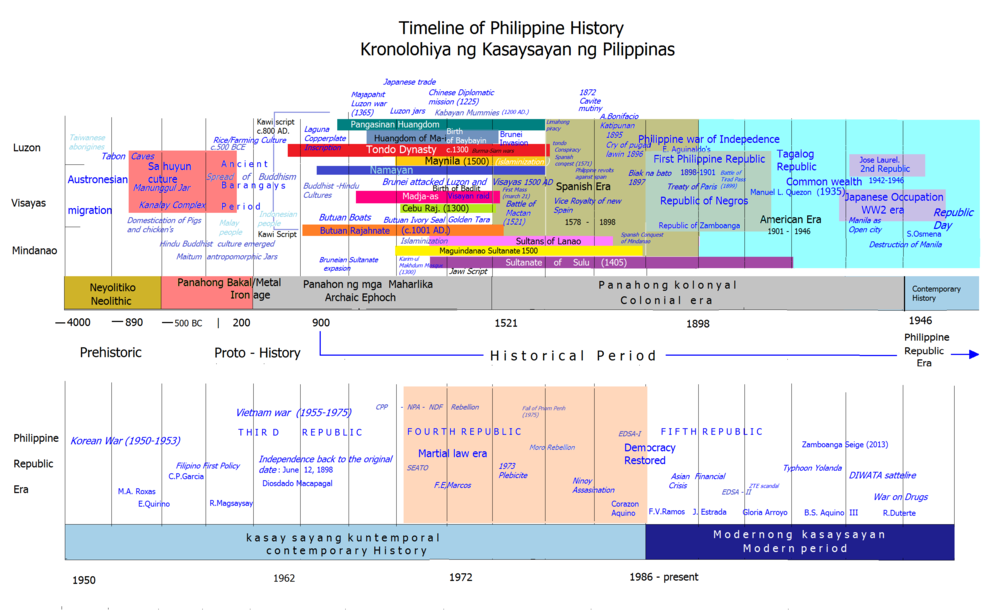 |
 Dates are approximate, consult particular article for details Prehistoric (or Proto-historic) Iron Age Historic Iron Age 日付は概算であり、詳細は個々の記事を参照のこと 先史時代(または原史時代) 鉄器時代 歴史時代 鉄器時代 |
| Prehistory Main article: Prehistory of the Philippines Docking station and entrance to the Tabon Cave Complex Site in Palawan, where one of the oldest human remains was located. Stone tools and fossils of butchered animal remains discovered in Rizal, Kalinga are evidences of early hominins in the country to as early as 709,000 years.[1] Researchers found 57 stone tools near rhinoceros bones bearing cut marks and some bones smashed open, suggesting that the early humans were after the nutrient-rich marrow.[24] A 2023 study dated the age of fossilized remains of Homo luzonensis of Cagayan at about 134,000 years.[4] This and the Angono Petroglyphs in Rizal suggest the presence of human settlement before the arrival of the Negritos and Austronesian speaking people.[25][26] The Callao Man remains and 12 bones of three hominin individuals found by subsequent excavations in Callao Cave were later identified to belong in a new species named Homo luzonensis.[3] For modern humans, the Tabon Man remains are the still oldest known at about 47,000 years.[5] The Negritos were early settlers,[6] but their appearance in the Philippines has not been reliably dated.[27] They were followed by speakers of the Malayo-Polynesian languages, a branch of the Austronesian language family. The first Austronesians reached the Philippines at 3000–2200 BCE, settling the Batanes Islands and northern Luzon. From there, they rapidly spread downwards to the rest of the islands of the Philippines and Southeast Asia, as well as voyaging further east to reach the Northern Mariana Islands by around 1500 BCE.[8][28][29][30] They assimilated the earlier Australo-Melanesian Negritos, resulting in the modern Filipino ethnic groups that all display various ratios of genetic admixture between Austronesian and Negrito groups.[31][32] Before the expansion out of Taiwan, archaeological, linguistic and genetic evidence had linked Austronesian speakers in Insular Southeast Asia to cultures such as the Hemudu, its successor the Liangzhu[30][33] and Dapenkeng in Neolithic China.[34][35][36][37][38] The most widely accepted theory of the population of the islands is the "Out-of-Taiwan" model that follows the Austronesian expansion during the Neolithic in a series of maritime migrations originating from Taiwan that spread to the islands of the Indo-Pacific; ultimately reaching as far as New Zealand, Easter Island, and Madagascar.[28][39] Austronesians themselves originated from the Neolithic rice-cultivating pre-Austronesian civilizations of the Yangtze River delta in coastal southeastern China pre-dating the conquest of those regions by the Han Chinese. This includes civilizations like the Liangzhu culture, Hemudu culture, and the Majiabang culture.[40] It connects speakers of the Austronesian languages in a common linguistic and genetic lineage, including the Taiwanese indigenous peoples, Islander Southeast Asians, Chams, Islander Melanesians, Micronesians, Polynesians, and the Malagasy people. Aside from language and genetics, they also share common cultural markers like multihull and outrigger boats, tattooing, rice cultivation, wetland agriculture, teeth blackening, jade carving, betel nut chewing, ancestor worship, and the same domesticated plants and animals (including dogs, pigs, chickens, yams, bananas, sugarcane, and coconuts).[28][39][41] A 2021 genetic study examining representatives of 115 indigenous communities found evidence of at least five independent waves of early human migration. Negrito groups, divided between those in Luzon and those in Mindanao, may come from a single wave and diverged subsequently, or through two separate waves. This likely occurred sometime after 46,000 years ago. Another Negrito migration entered Mindanao sometime after 25,000 years ago. Two early East Asian waves were detected, one most strongly evidenced among the Manobo people who live in inland Mindanao, and the other in the Sama-Bajau and related people of the Sulu archipelago, Zamboanga Peninsula, and Palawan. The admixture found in the Sama people indicates a relationship with the Htin and Mlabri people of mainland Southeast Asia, both peoples being speakers of an Austroasiatic language and reflects a similar genetic signal found in western Indonesia. These happened sometime after 15,000 years ago and 12,000 years ago respectively, around the time the last glacial period was coming to an end. Austronesians, either from Southern China or Taiwan, were found to have come in at least two distinct waves. The first, occurring perhaps between 10,000 and 7,000 years ago, brought the ancestors of indigenous groups that today live around the Cordillera Central mountain range. Later migrations brought other Austronesian groups, along with agriculture, and the languages of these recent Austronesian migrants effectively replaced those existing populations. In all cases, new immigrants appear to have mixed to some degree with existing populations. The integration of Southeast Asia into Indian Ocean trading networks around 2,000 years ago also shows some impact, with South Asian genetic signals present within some Sama-Bajau communities. There is also some Papuan migration to Southeast Mindanao as Papuan genetic signatures were detected in the Sangil and Blaan ethnic groups.[7] By 1000 BCE, the inhabitants of the Philippine archipelago had developed into four distinct kinds of peoples: tribal groups, such as the Aetas, Hanunoo, Ilongots and the Mangyan who depended on hunter-gathering and were concentrated in forests; warrior societies, such as the Isneg and Kalinga who practiced social ranking and ritualized warfare and roamed the plains; the petty plutocracy of the Ifugao Cordillera Highlanders, who occupied the mountain ranges of Luzon; and the harbor principalities of the estuarine civilizations that grew along rivers and seashores while participating in trans-island maritime trade.[42] It was also during the first millennium BCE that early metallurgy was said to have reached the archipelagos of maritime Southeast Asia via trade with India[43][44] Around 300–700 CE, the seafaring peoples of the islands traveling in balangays began to trade with the Indianized kingdoms in the Malay Archipelago and the nearby East Asian principalities, adopting influences from both Buddhism and Hinduism.[45] |
先史時代 詳細は「フィリピンの先史時代」を参照 パラワン州にあるタボン洞窟複合遺跡のドッキングステーションと入り口。最古の人骨のひとつが発見された場所である。 カリンガ州リザルで発見された石器や動物の化石は、フィリピンに70万9000年前には初期の人類が存在していたことを示す証拠である。[1] 研究者は、切断痕のあるサイの骨の近くに57個の石器を発見し、一部の骨が粉砕されていたことから、初期の人類は栄養豊富な骨髄を狙っていたことが示唆さ れた。[24] 2023年の研究では、 カガヤン(フィリピン)のホモ・ルソンエンシスの化石は約13万4000年前のものであることが分かった。 これとリサール州のアンゴノ岩絵は、ネグリト人とオーストロネシア語族の話者が到来する以前に、すでに人類が定住していたことを示唆している。[25] [26] カヤオ洞窟でその後の発掘調査により発見されたカヤオ人の遺骨と3人の原人の12個の骨は、後にホモ・ルソンエンシスという新種に属することが確認され た。[3] 現生人類では、タボン人の遺骨が約4万7000年前のもので、現在知られている中で最も古いものである。47,000年ほど前のものとされている。 ネグリト人は初期の入植者であったが[6]、フィリピンへの彼らの到来は正確な年代が特定されていない。[27] 彼らに続いて、オーストロネシア語族のマライ・ポリネシア語派を話す人々がやってきた。最初のオーストロネシア人は紀元前3000年から2200年の間に フィリピンに到達し、バタン諸島とルソン島北部に定住した。 そこから彼らは急速にフィリピンと東南アジアの他の島々へと南下し、さらに東へ航海して紀元前1500年頃には北マリアナ諸島に到達した。[8][28] [29][30] 彼らはそれ以前にオーストラロネシア語族のネグリト人と融合し、その結果、現代のフィリピン人民族グループが生まれた。この民族グループはすべて、オース トロネシア語族とネグリト人のグループとの間の様々な比率の遺伝的混血を示している。[31][32] 台湾から拡散する以前、考古学的、言語学的、遺伝学的な証拠から、東南アジアの島嶼部におけるオーストロネシア語族の話者は、中国の青銅器時代の文化であ る河姆渡文化やその後の良渚文化[30][33]、大汶口文化[34][35][36][37][38]と関連付けられていた。 島嶼部の民族に関する最も広く受け入れられている理論は、「台湾外」モデルと呼ばれるもので、新石器時代に台湾から始まった一連の海洋移民により、インド 太平洋の島々に広がったオーストロネシア語族の拡張を追うものである。最終的には、ニュージーランド、イースター島、マダガスカルにまで到達した。 [28][39] オーストロネシア人自身は、新石器時代の稲作を行うオーストロネシア語族以前の文明である長江デルタの 漢民族によるそれらの地域の征服に先立つ、中国南東部の長江デルタにおける新石器時代の稲作を行う先オーストロネシア文明に起源を持つ。 これには、良渚文化、河姆渡文化、馬家畳文化などの文明が含まれる。[40] オーストロネシア語族の言語話者は、台湾の先住民、東南アジアの島民、チャム族、メラネシアの島民、ミクロネシア人、ポリネシア人、マダガスカルの人々な ど、共通の言語的・遺伝的系統でつながっている。言語や遺伝学以外にも、彼らは多船やアウトリガー・カヌー、入れ墨、稲作、湿地農業、歯の黒色化、ヒスイ の彫刻、ビンロウの実の咀嚼、祖先崇拝、そして同じ家畜化された植物や動物(犬、豚、鶏、ヤムイモ、バナナ、サトウキビ、ココナッツなど)といった共通の 文化的な特徴も共有している。[28][39][41] 2021年の遺伝子研究では、115の先住民族コミュニティの代表者を対象に調査を行い、少なくとも5つの独立した初期の人類移動の波の証拠を発見した。 ルソン島とミンダナオ島に分かれているネグリト族は、単一の波から派生したか、あるいは2つの別々の波によって分岐した可能性がある。これは、4万 6000年前以降に起こった可能性が高い。また、2万5000年ほど前にネグリト族の別の移住がミンダナオ島で起こった。初期の東アジア系民族の2つの波 が確認されており、そのうちの1つはミンダナオ島の内陸に住むマノボ族に最も強く表れており、もう1つはスールー諸島、ザンボアンガ半島、パラワン島に住 むサマ・バジャウ族および関連民族に表れている。サマ族に見られる混血は、東南アジア本土のティン族とムラブリ族との関係を示しており、両民族はともに オーストロアジア語族の言語を話す民族である。また、インドネシア西部で見られる類似した遺伝子シグナルを反映している。これらは、最終氷河期が終焉を迎 えつつあった時期に、それぞれ1万5000年前と1万2000年前以降に起こった。オーストロネシア人は、中国南部または台湾から、少なくとも2つの異な る波でやってきたことが分かっている。最初の波は、おそらく1万~7千年前に起こり、現在コルディリェラ山脈周辺に住む先住民族の祖先を連れてきた。その 後の移住では、農業とともに他のオーストロネシア人グループがやってきた。これらの最近のオーストロネシア人移住者の言語は、既存の人口を効果的に置き換 えた。いずれの場合も、新しい移民は既存の住民とある程度混血したようである。2000年ほど前に東南アジアがインディアン・オーシャン貿易網に統合され たことも、ある程度の影響を与えているようで、サマ・バジャウ族のコミュニティの一部には南アジアの遺伝的特徴が見られる。また、パプア人の遺伝的特徴が サンギル族とブラアン族の民族集団で検出されたことから、ミンダナオ島南東部にはパプア人の移住もあったようである。 紀元前1000年頃には、フィリピン諸島の住民は4つの異なる民族に発展していた。すなわち、狩猟採集に依存し、森林地帯に集中していた種族グループ、例 えば、アエタ族、ハヌノオ族、イロンゴット族、マンギャン族など。社会的な階級制度を実践し、儀式化された戦争を行い、平原を放浪していた戦士社会、例え ば、イスネグ族やカリンガ族など。ルソン島の山岳地帯を占領したイフガオ・コーディリエラ高地人の小規模な寡頭政治、そして河川や海岸沿いに発展し、島を またいだ海上貿易に参加していた河口文明の港湾公国などである。[42] また、初期の冶金技術がインドとの貿易を通じて東南アジアの海洋諸島に伝わったとされるのも、紀元前1千年紀のことである。[43][44] 西暦300年から700年頃、バランガイに乗って航海する島々の人々は、マレー諸島にあるインド化された王国や近隣の東アジアの諸侯国と交易を始め、仏教 とヒンドゥー教の両方の影響を取り入れた。[45] |
| Maritime Jade Road The Maritime Jade Road was initially established by the animist indigenous peoples between the Philippines and Taiwan, and later expanded to cover Vietnam, Malaysia, Indonesia, Thailand, and other countries.[46] Artifacts made from white and green nephrite have been discovered at a number of archeological excavations in the Philippines since the 1930s. The artifacts have been both tools like adzes[47] and chisels, and ornaments such as lingling-o earrings, bracelets and beads.[9] Tens of thousands were found in a single site in Batangas.[48][49] The jade is said to have originated nearby in Taiwan and is also found in many other areas in insular and mainland Southeast Asia. These artifacts are said to be evidence of long range communication between prehistoric Southeast Asian societies.[50] Throughout history, the Maritime Jade Road has been known as one of the most extensive sea-based trade networks of a single geological material in the prehistoric world, existing for 3,000 years from 2000 BCE to 1000 CE.[51][52][53][54] The operations of the Maritime Jade Road coincided with an era of near absolute peace which lasted for 1,500 years, from 500 BCE to 1000 CE.[55] During this peaceful pre-colonial period, not a single burial site studied by scholars yielded any osteological proof for violent death. No instances of mass burials were recorded as well, signifying the peaceful situation of the islands. Burials with violent proof were only found from burials beginning in the 15th century, likely due to the newer cultures of expansionism imported from India and China. When the Spanish arrived in the 16th century, they recorded some warlike groups, whose cultures have already been influenced by the imported Indian and Chinese expansionist cultures of the 15th century.[56] |
海上の翡翠の道 海上の翡翠の道は、当初はフィリピンと台湾の間に住む精霊信仰の土着民族によって確立され、後にベトナム、マレーシア、インドネシア、タイ、その他の国々 にも拡大した。[46] 1930年代以降、フィリピンでは数多くの考古学的発掘調査で、白や緑のネフライトでできた工芸品が発見されている。これらの遺物は、手斧やノミなどの道 具類と、リンリン・オー・ピアス、ブレスレット、ビーズなどの装飾品に分けられる。 バタンガス州の単一の遺跡から、数万点が発見されている。これらの遺物は、先史時代の東南アジア社会間の長距離にわたる交流の証拠であると考えられてい る。[50] 歴史を通じて、海上の翡翠の道は、先史時代における単一の地質物質を基盤とした最も広範囲にわたる海上貿易ネットワークのひとつとして知られており、紀元 前2000年から西暦1000年までの3000年にわたって存在していた。[51][52][53][54] 海上の翡翠の道の活動は、 紀元前500年から西暦1000年までの1500年間続いた、ほぼ完全な平和の時代と一致している。[55] この植民地化以前の平和な時代には、学者が調査した埋葬地では、暴力的な死を証明する骨学的証拠はひとつも見つからなかった。集団埋葬の例も記録されてお らず、これはその島々の平和的な状況を示している。暴力的な死の痕跡のある埋葬は、15世紀以降の埋葬からしか発見されておらず、これはおそらくインドや 中国から持ち込まれた拡張主義の新しい文化によるものと思われる。16世紀にスペイン人が到着した際、彼らはいくつかの好戦的な集団を記録しているが、そ れらの文化はすでに15世紀に持ち込まれたインディアンや中国の拡張主義文化の影響を受けていた。[56] |
| The Sa Huỳnh culture See also: Kalanay Cave Asia in 200 BCE, showing the Sa Huỳnh culture in Mainland Southeast Asia and the Philippines in transition. The Sa Huỳnh culture centered on present-day Vietnam, showed evidence of an extensive trade network. Sa Huỳnh beads were made from glass, carnelian, agate, olivine, zircon, gold and garnet; most of these materials were not local to the region, and were most likely imported. Han dynasty-style bronze mirrors were also found in Sa Huỳnh sites. Conversely, Sa Huỳnh produced ear ornaments have been found in archaeological sites in Central Thailand, Taiwan (Orchid Island), and in the Philippines, in the Palawan, Tabon Caves. One of the great examples is the Kalanay Cave in Masbate; the artefacts on the site in one of the "Sa Huỳnh-Kalanay" pottery complex sites were dated 400BCE–1500 CE. The Maitum anthropomorphic pottery in the Sarangani Province of southern Mindanao is c. 200 CE.[57][58] Ambiguity of what is Sa Huỳnh culture puts into question its extent of influence in Southeast Asia. Sa Huỳnh culture is characterized by use of cylindrical or egg-shaped burial jars associated with hat-shaped lids. Using its mortuary practice as a new definition, Sa Huỳnh culture should be geographically restricted across Central Vietnam between Hue City in the north and Nha Trang City in the south. Recent archeological research reveals that the potteries in Kalanay Cave are quite different from those of the Sa Huỳnh but strikingly similar to those in Hoa Diem site, Central Vietnam and Samui Island, Thailand. New estimate dates the artifacts in Kalanay cave to come much later than Sa Huỳnh culture at 200–300 CE. Bio-anthropological analysis of human fossils found also confirmed the colonization of Vietnam by Austronesian people from insular Southeast Asia in, e.g., the Hoa Diem site.[59][60] |
サホイ文化 関連情報:カラナイ洞窟 紀元前200年のアジア。東南アジア本土とフィリピンにおける移行期のサホイ文化を示す。 現在のベトナムを中心とするサフイン文化では、広範囲にわたる交易ネットワークの存在を示す証拠が見つかっている。サフインのビーズはガラス、カーネリア ン、メノウ、カンラン石、ジルコン、金、ガーネットなどから作られており、これらの素材のほとんどは現地のものではなく、おそらく輸入されたものと考えら れる。また、サフインの遺跡からは漢王朝様式の青銅鏡も発見されている。 逆に、サフインで生産された耳飾りは、タイ中央部、台湾(蘭嶼)、フィリピンのパラワン州タボン洞窟の遺跡から発見されている。その好例のひとつがマスバ テ州のカラナヤ洞窟で、この「サ・フイン-カラナヤ」陶器複合遺跡の遺物は紀元前400年から西暦1500年のものとされている。ミンダナオ島南部のサラ ンガニ州にあるマイツムの擬人像陶器は西暦200年頃のものである。 サ・フイン文化の定義が曖昧であるため、東南アジアにおけるその影響範囲については疑問が残る。サ・フイン文化は、円筒形または卵形の壷に帽子形の蓋を組 み合わせたものが特徴である。その埋葬の慣習を新たな定義として使用すると、サ・フイン文化は地理的にベトナム中部のフエ市から南のニャチャン市までの地 域に限定されるべきである。最近の考古学調査により、カラナ洞窟の土器はサ・フインの土器とはかなり異なるが、ベトナム中部のホア・ディエム遺跡やタイの サムイ島にある土器と驚くほど類似していることが明らかになっている。新たな推定では、カラナ洞窟の遺物は、サフイン文化よりもはるかに後の西暦200年 から300年のものである。また、ホア・ディエム遺跡などから発見された人類化石の生物人類学的分析により、島嶼性の東南アジアから来たオーストロネシア 人がベトナムに定住していたことが確認された。[59][60] |
Precolonial period (AD 900 to
1565) – Independent polities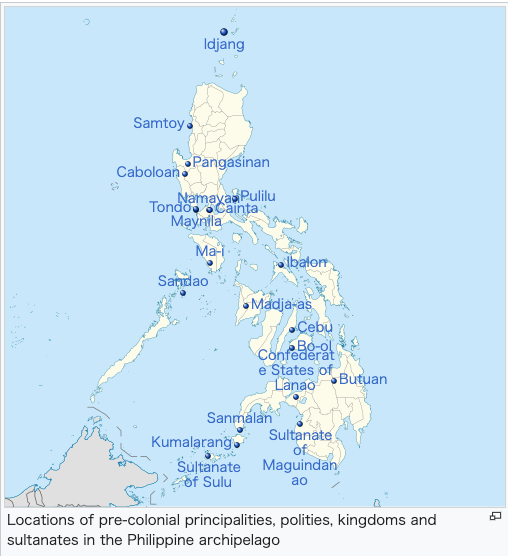 Main article: History of the Philippines (900–1565) History of the Philippines is located in PhilippinesIdjangIdjangPangasinanPangasinanMaynilaMaynilaMadja-asMadja-asButuanButuanSultanate of SuluSultanate of SuluKumalarangKumalarangSanmalanSanmalanMa-iMa-iSandaoSandaoBo-olBo-olSultanate of MaguindanaoSultanate of MaguindanaoCebuCebuNamayanNamayanTondoTondoPuliluPuliluConfederate States of LanaoConfederate States of LanaoCaintaCaintaCaboloanCaboloanIbalonIbalonSamtoySamtoy Locations of pre-colonial principalities, polities, kingdoms and sultanates in the Philippine archipelago Also known to a lesser extent as the Pre-Philippines period, is a pre-unification period characterized by many independent states known as polities each with its own history, cultures, chieftains, and governments distinct from each other. According to sources from Southern Liang, people from the kingdom of Langkasuka in present-day Thailand were wearing cotton clothes made in Luzon, Philippines as early as 516–520 CE.[61] The British Historian Robert Nicholl citing Arab chronicler Al Ya'akubi, had written that on the early years of the 800s, the kingdoms of Muja (then Pagan Brunei) and Mayd (Ma-i) waged war against the Chinese Empire.[62] Medieval Indian scholars also referred to the Philippines as "Panyupayana" (The lands surrounded by water).[63] By the 1300s, a number of the large coastal settlements had emerged as trading centers, and became the focal point of societal changes.[11] The Barangic Phase of history can be noted for its highly mobile nature, with barangays transforming from being settlements and turning into fleets and vice versa, with the wood constantly re-purposed according to the situation.[64] Politics during this era was personality-driven and organization was based on shifting alliances and contested loyalties set in a backdrop of constant inter-polity interactions, both through war and peace.[16] Legendary accounts often mention the interaction of early Philippine polities with the Srivijaya empire, but there is not much archaeological evidence to definitively support such a relationship.[11] Considerable evidence exists, on the other hand, for extensive trade with the Majapahit empire.[65] The exact scope and mechanisms of Indian cultural influences on early Philippine polities are still the subject of some debate among Southeast Asian historiographers,[11][66] but the current scholarly consensus is that there was probably little or no direct trade between India and the Philippines,[11][66] and Indian cultural traits, such as linguistic terms and religious practices,[65] filtered in during the 10th through the early 14th centuries, through early Philippine polities' relations with the Hindu Majapahit empire.[11] The Philippine archipelago is thus one of the countries, (others include Afghanistan and Southern Vietnam) just at the outer edge of what is considered the "Greater Indian cultural zone".[66] The early polities of the Philippine archipelago were typically characterized by a three-tier social structure. Although different cultures had different terms to describe them, this three-tier structure invariably consisted of an apex nobility class, a class of "freemen", and a class of dependent debtor-bondsmen called "alipin" or "oripun."[11][16] Among the members of the nobility class were leaders who held the political office of "Datu," which was responsible for leading autonomous social groups called "barangay" or "dulohan".[11] Whenever these barangays banded together, either to form a larger settlement[11] or a geographically looser alliance group,[16] the more senior or respected among them would be recognized as a "paramount datu", variedly called a Lakan, Sultan, Rajah, or simply a more senior Datu.[64][11][42] Eventually, by the 14th to 16th century, inter-kingdom warfare escalated[67] and population densities across the archipelago was low.[68] |
植民地化以前(西暦900年から1565年) - 独立した政治体制 詳細は「フィリピンの歴史 (900年-1565年)」を参照 フィリピンの歴史は、フィリピン、パンパンガ州、パンパンガ州、マニラ、マニラ、マジャ-アス、マジャ-アス、ブトゥアン、ブトゥアン、スールー王国、 スールー王国、クマララン、クマララン、サンマラン、サンマラン、マイマイ、マイマイ、サンダオ、サンダオ、ボオル、ボオル、マギンダナオ王国、マギンダ ナオ王国、セブ セブ セブ ナマヤン ナマヤン トンド トンド プリリウ プリリウ ラナオ連合州 ラナオ連合州 ケソン市 ケソン市 カボローン カボローン イバロン イバロン サムトイ サムトイ フィリピン諸島における植民地化以前の主な公国、政体、王国、スルタン国の位置 フィリピン統一以前の時代は、あまり知られていないが、統一以前の時代は、それぞれ独自の歴史、文化、首長、政府を持つ多くの独立国家として特徴づけられ る。南梁の資料によると、西暦516年から520年には、現在のタイのランカスカ王国の人々はフィリピンのルソン島で生産された木綿の服を着ていたとい う。[61] アラブの年代記編者アル・ヤアクービーを引用したイギリスの歴史家ロバート・ニコルは、800年代初頭にはムージャ王国(当時のパガン・ブルネイ)とメイ ド王国(マイ )は中国帝国に対して戦争を仕掛けたと書いている。[62] 中世のインディアンの学者たちもフィリピンを「Panyupayana」(水に囲まれた土地)と呼んでいた。[63] 1300年代には、沿岸部の大規模な集落のいくつかが交易の中心地として台頭し、社会変化の中心となった。[11] バラング族の時代は、その高い流動性で注目される。バラング族は集落から船団へと、またその逆へと変貌を遂げ、状況に応じて木材を常に再利用していた。 [64] この時代の政治は人格主導型であり、組織は同盟関係の変化と、 戦時と平時を問わず、国家間の絶え間ない相互作用を背景に、同盟関係が変化し、忠誠心が争われる中で組織化されていた。 伝説によると、初期のフィリピン国家とシュリーヴィジャヤ帝国との交流がしばしば言及されているが、そのような関係を明確に裏付ける考古学的証拠はあまり ない。[11] 一方、マジャパイト帝国との広範な交易を示す証拠は数多く存在する。[65] 初期のフィリピン諸国に対するインド文化の影響の正確な範囲とメカニズムについては、東南アジアの歴史学者の間でも議論が続いているが[11][66]、 現在の学術的なコンセンサスでは、インドとフィリピン間の直接的な貿易はほとんど、あるいはまったく存在しなかった可能性が高いという見解が示されている [11][66]。インド文化の特徴、例えば言語用語や宗教的慣習などは[65]、10世紀から14世紀初頭にかけて、初期のフィリピン諸国とヒンドゥー 教のマジャパイト帝国との関係を通じて浸透したものである ヒンドゥー教のマジャパイト帝国との関係を通じて、インド文化の特徴が浸透した。[11] フィリピン諸島は、このように「大インド文化圏」の境界線上にある国々(アフガニスタンや南ベトナムなど)のひとつである。[66] フィリピン諸島の初期の政治体制は、典型的に3層構造の社会構造によって特徴づけられていた。異なる文化では異なる呼称が使われていたが、この3層構造は 常に、頂点に立つ貴族階級、自由民階級、そして「アリピン」または「オリプン」と呼ばれる被支配者の債務奴隷階級から構成されていた。[11][16] 貴族階級のメンバーの中には、「ダトゥ」という政治的役職に就く指導者もおり、彼らは「バランガイ」または「ドゥロハン」と呼ばれる自治的社会集団を率い ていた。[1 1] これらのバランガイがまとまって、より大きな集落を形成したり[11]、あるいは地理的に緩やかな同盟グループを形成したり[16]するたびに、その中で より地位の高い者や尊敬を集めている者が「パラマウント・ダトゥ」として認められ、ラカン、スルタン、ラジャなど、あるいは単に年長のダトゥなどと呼ばれ た。[64][11][42] 最終的に、14世紀から16世紀にかけて、王国間の戦乱が激化し [67] また、列島全体の人口密度は低かった。[68] |
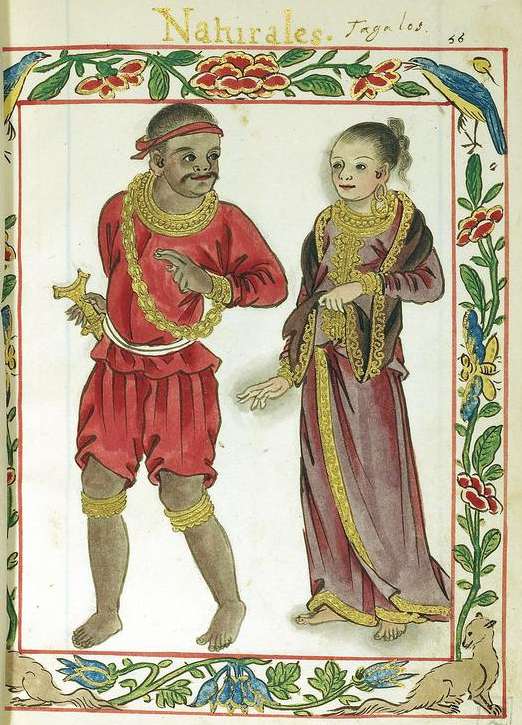 Native Royalties in Pre-hispanic Philippine Archipelago A Boxer Codex image illustrating the 1590's Tagalog Maginoo (noble class). |
 フィリピン群島におけるスペイン人到来以前の土着の王族たち 1590年代のタガログ語のMaginoo(マニノオ)(貴族階級)を表したボクサー・コーデックスの画像。 |
| Initial recorded history During the period of the south Indian Pallava dynasty and the north Indian Gupta Empire, Indian culture spread to Southeast Asia and the Philippines that led to the establishment of Indianized kingdoms.[69][70] The date inscribed in the oldest Philippine document found so far, the Laguna Copperplate Inscription, is 900 CE. From the details of the document, written in Kawi script, the bearer of a debt, Namwaran, along with his children Lady Angkatan and Bukah, are cleared of a debt by the ruler of Tondo. It is the earliest document that shows the use of mathematics in precolonial Philippine societies. A standard system of weights and measures is demonstrated by the use of precise measurement for gold, and familiarity with rudimentary astronomy is shown by fixing the precise day within the month in relation to the phases of the moon.[71] From the various Sanskrit terms and titles seen in the document, the culture and society of Manila Bay was that of a Hindu–Old Malay amalgamation, similar to the cultures of Java, Peninsular Malaysia and Sumatra at the time. There are no other significant documents from this period of precolonial Philippine society and culture until the Doctrina Christiana of the late 16th century, written at the start of the Spanish period in both native Baybayin script and Spanish. Other artifacts with Kawi script and baybayin were found, such as an Ivory seal from Butuan dated to the early 10th–14th centuries[72][73] and the Calatagan pot with baybayin inscription, dated to not later than early 16th century.[74] In the years leading up to 1000, there were already several maritime societies existing in the islands but there was no unifying political state encompassing the entire Philippine archipelago. Instead, the region was dotted by numerous semi-autonomous barangays (settlements ranging in size from villages to city-states) under the sovereignty of competing thalassocracies ruled by datus, wangs, rajahs, sultans or lakans.[75] or by upland agricultural societies ruled by "petty plutocrats". A number of states existed alongside the highland societies of the Ifugao and Mangyan.[76][77] These included: Kingdom of Maynila Tondo Namayan Cainta Kumintang the Kingdom of Taytay in Palawan (mentioned by Antonio Pigafetta to be where they resupplied when the remaining ships escaped Cebu after Magellan was slain) the Chieftaincy of Coron Island ruled by fierce warriors called Tagbanua as reported by Spanish missionaries mentioned by Nilo S. Ocampo,[78] Pangasinan Caboloan Ma-i and its vassal-states of Sandao and Pulilu Madja-as Bo-ol the Hindu kingdoms of Sanmalan, Butuan, and Cebu the sultanates of Buayan, Maguindanao, Lanao, and Sulu Some of these regions were part of the Malayan empires of Srivijaya, Majapahit and Brunei.[79][80][81] |
初期の記録された歴史 南インドのパッラヴァ朝と北インドのグプタ帝国の時代に、インド文化が東南アジアとフィリピンに広がり、インド化された王国の建国につながった。 現在までに発見された最古のフィリピン文書であるラグナ銅版碑文に記された日付は西暦900年である。 カウィ文字で書かれた文書の記述によると、債務者のナムワランとその子供であるレディ・アンガハタンとブカが、トンドの支配者によって債務を帳消しにされ ている。これは、植民地化以前のフィリピン社会における数学の使用を示す最古の文書である。標準的な重量および測定のシステムは、金に対する正確な測定の 使用によって示されており、初歩的な天文学に精通していることは、月の相に関連して月のうちの正確な日を特定することによって示されている。[71] この文書に登場するさまざまなサンスクリット語の用語や称号から、マニラ湾の文化や社会は、当時ジャワやマレー半島マレーシア、スマトラの文化と類似した ヒンドゥー教と旧マレー文化の融合であったことがわかる。 スペイン植民地時代以前のフィリピンの社会と文化に関するこの時代の重要な文書は、スペイン植民地時代初期に現地のババイイン文字とスペイン語で書かれた 16世紀後半の『ドクトリナ・クリスティアーナ』まで存在しない。ブトゥアンから出土した象牙の印章(10世紀初頭から14世紀初頭のものとされる) [72][73]や、カラタガン鉢(16世紀初頭以前のものとされる)[74]など、カウィ文字やババイイン文字が刻まれた他の遺物も発見されている。 1000年頃には、すでに島々にはいくつかの海洋社会が存在していたが、フィリピン諸島全体を包括する統一された政治国家は存在していなかった。その代わ り、この地域には、ダトゥ、ワン、ラジャ、スルタン、ラカンなどが支配する海洋勢力による主権の下、多数の半自治的なバランガイ(村落から都市国家までの 規模の集落)が点在していた。あるいは、「小富豪」が支配する高地農業社会が存在していた。イフガオ族やマンギャン族の高地社会と並んで、多くの国家が存 在していた。[76][77] それらには以下が含まれる。 マイニラ王国 トンダ ナマヤン カインタ クムンタン パラワン州のタイタイ王国(マゼランが殺害された後、残りの船がセブ島から脱出した際に補給を行った場所として、アントニオ・ピガフェッタによって言及さ れている) ニロ・S・オカンポが言及したスペイン人宣教師が報告したタガバヌアと呼ばれる猛々しい戦士たちによって統治されたコロン島の首長国、 パンガシナン カボロアン マイおよびその属国であるサンダオとプリル マジャアス ボオル サンマラン、ブトゥアン、セブのヒンドゥー王国 ブアヤン、マギンダナオ、ラナオ、スールーのサルタン国 これらの地域の一部は、シュリーヴィジャヤ、マジャパイト、ブルネイのマレー諸国に属していた。[79][80][81] |
| The polity of Tondo Main articles: Tondo (historical polity) and History of Manila The Laguna Copperplate Inscription, c. 900 CE. The oldest known historical record found in the Philippines, which indirectly refers to the polity of Tondo Tondo was a major trade hub on Luzon island in the northern part of the Pasig River delta. The earliest historical record of local polities and kingdoms, the Laguna Copperplate Inscription, indirectly refers to the Tagalog polity of Tondo (c. before 900–1589) and two to three other settlements believed to be located somewhere near Tondo, as well as a settlement near Mt. Diwata in Mindanao, and the temple complex of Medang in Java.[82] Although the precise political relationships between these polities is unclear in the text of the inscription, the artifact is usually accepted as evidence of intra- and inter-regional political linkages as early as 900.[82][64][16] By the arrival of the earliest European ethnographers during the 1500s, Tondo was led by the paramount ruler called a "Lakan".[64][16] It had grown into a major trading hub, sharing a monopoly with the Rajahnate of Maynila over the trade of Ming dynasty[83] products throughout the archipelago.[64] This trade was significant enough that the Yongle Emperor appointed a Chinese governor named Ko Ch'a-lao to oversee it.[84][85] Since at least the year 900, this thalassocracy centered in Manila Bay flourished via an active trade with Chinese, Japanese, Malays, and various other peoples in Asia. Tondo thrived as the capital and the seat of power of this ancient kingdom, which was led by kings under the title "Lakan" that belongs to the caste of the Maharlika, who were the feudal warrior class in ancient Tagalog society. At its height, they ruled a large part of what is now known as Luzon from Ilocos to Bicol from possibly before 900 CE to 1571, becoming the largest precolonial state. The Spaniards called them Hidalgos.[86][87] The people of Tondo had developed a culture that is predominantly Hindu and Buddhist, they were also good agriculturists, and lived through farming and aquaculture. During its existence, it grew to become one of the most prominent and wealthy kingdom states in precolonial Philippines due to heavy trade and connections with several neighboring nations such as China and Japan. Due to its very good relations with Japan, the Japanese called Tondo as Luzon, even a famous Japanese merchant, Luzon Sukezaemon, went as far as to change his surname from Naya to Luzon.[88] Japan's interaction with Philippine states have precedence in the 700s when Austronesian peoples like the Hayato and Kumaso settled in Japan and culturally mediated with the locals and their Austronesian kin to the south, served at the Imperial court and sometimes waged battles in Japan.[89] Japan also imported Mishima ware manufactured in Luzon.[90] In 900 CE, the lord-minister Jayadewa presented a document of debt forgiveness to Lady Angkatan and her brother Bukah, the children of Namwaran. This is described in the Philippines' oldest known document, the Laguna Copperplate Inscription.[91] The Chinese also mention a polity called "Luzon." This is believed to be a reference to Maynila since Portuguese and Spanish accounts from the 1520s explicitly state that "Luçon" and "Maynila" were "one and the same",[64] although some historians argue that since none of these observers actually visited Maynila, "Luçon" may simply have referred to all the Tagalog and Kapampangan polities that rose up on the shores of Manila Bay.[92] |
トンドの政治体制 主な記事:トンド(歴史的体制)とマニラの歴史 ラグナ銅版碑文、西暦900年頃。フィリピンで発見された最古の歴史的記録であり、間接的にトンドの政治体制について言及している トンドはパシグ川デルタ北部のルソン島にある主要な貿易拠点であった。この地域における最古の政治体制や王国に関する歴史的記録であるラグナ銅版碑文は、 間接的にタガログ人のトンド政体を参照している(900年頃~1589年)。また、トンド近辺に位置すると考えられている2~3の他の集落、およびミンダ ナオ島のディワタ山近辺の集落、ジャワのメダン寺院複合施設についても言及している。[82] これらの政治体制間の正確な政治的関係は碑文の本文では不明であるが、 碑文の本文では不明であるが、この遺物は通常、900年にはすでに地域内および地域間の政治的つながりの証拠として認められている。[82][64] [16] 1500年代にヨーロッパのエスノグラファーが到着したときには、トンドは「ラカン」と呼ばれる最高支配者に率いられていた。[64][16] トンドは主要な貿易拠点に成長し、マニラ・ラジャ家と独占的に 明王朝の製品[83]の貿易をフィリピン諸島全体で独占していた。この貿易は非常に重要であったため、永楽帝はこれを監督するために高察老という名の中国 人総督を任命した。 少なくとも900年以降、マニラ湾を中心に栄えた海洋国家は、中国、日本、マレーシア、その他アジアの諸民族との活発な交易によって繁栄した。古代タガロ グ社会における封建的な戦士階級であるマハルリカのカーカン(Lakan)の称号を持つ王が統治するこの古代王国の首都であり権力の中心地であったトンド は繁栄した。最盛期には、西暦900年以前から1571年まで、おそらくはイロコスからビコールまでのルソン島の大半を支配し、植民地化以前の国家として は最大規模となった。スペイン人は彼らを「ヒダルゴ」と呼んだ。[86][87] トンドの人々は主にヒンドゥー教と仏教の文化を発展させ、農業にも長けており、農業と水産養殖で生計を立てていた。その存在期間中、中国や日本など近隣諸 国との活発な貿易により、植民地化以前のフィリピンで最も著名で裕福な王国国家の一つに成長した。 日本との良好な関係により、日本人はトンドをルソンと呼び、有名な日本人商人であるルソン助左衛門は、苗字を名屋からルソンに変えるほどであった。 [88] 日本とフィリピンの諸国家との交流は、700年代に遡る。この時代には、ハヤトやクマソといったオーストロネシア語族の人々が日本に定住し、文化的に地元 民や南方のオーストロネシア語族の親戚と交流し、 宮廷で仕え、時には日本で戦いを繰り広げた。[89] また、ルソン島で製造された三島焼が日本に輸入されていた。[90] 西暦900年、宰相ジャヤデワは、ナムワランの子供であるアンガンタ夫人とその兄弟ブカに、債務免除の文書を贈った。これはフィリピンで最も古い文書とし て知られるラグナ銅板碑文に記されている。 中国人も「ルソン」と呼ばれる国家について言及している。これは、1520年代のポルトガルとスペインの記録では、「ルソン」と「マニラ」は「同一のもの である」と明確に述べられているため、マニラを指していると考えられているが[64]、一部の歴史家は、これらの観察者の誰もマニラを実際に訪れていない ため、「ルソン」は単にマニラ湾の沿岸に興ったタガログ族とパンパンガ族のすべての国家を指していた可能性があると主張している[92]。 |
| Cainta Main article: Cainta (historical polity) Cainta was a fortified upriver polity in present-day Rizal province that occupied both shores of an arm of the Pasig River. The river bisected it in the middle, a moat surrounded its log walls and stone bulwarks armed with native cannons (Lantakas) and the city itself was encased by Bamboo thickets.[93] |
カインタ 詳細は「カインタ (歴史的政体)」を参照 カインタは、パシグ川の支流の両岸を占める要塞化された上流の政体であり、現在のリサル州にあった。川は中央でそれを二分し、丸太の壁と、在来の大砲(ランタカ)を備えた石の防壁に囲まれた堀があり、その都市自体は竹藪に囲まれていた。 |
| Namayan Main article: Namayan 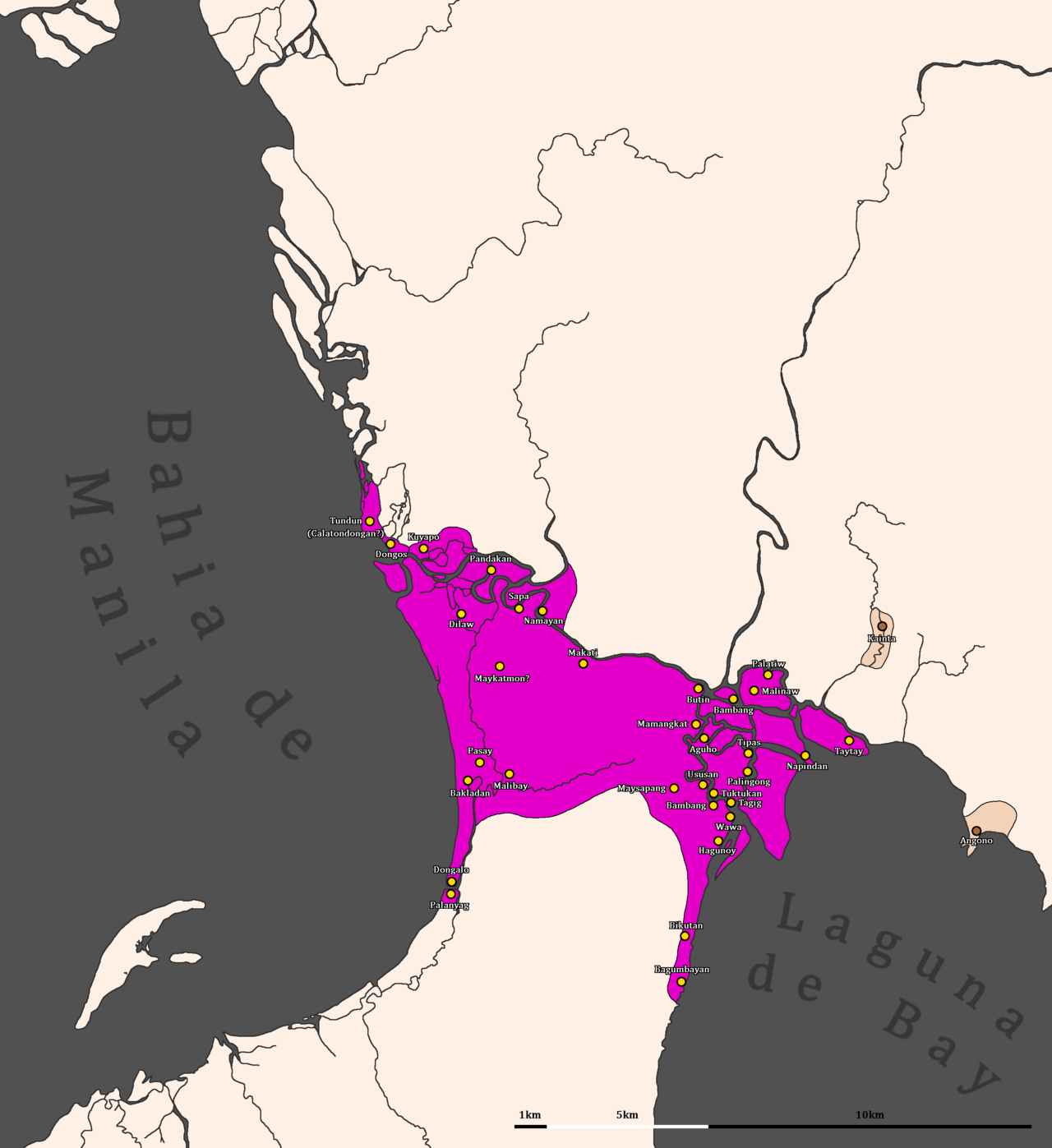 Map of Namayan (pink) under Lakantagkan according to the accounts of Felix Huerta. Calatondongan, Dibag, Pinacauasan and Yamagtogon are missing. Meycatmon's location is unclear. Namayan, also a Pasig river polity, arose as a confederation of local barangays.[94] Local tradition says that it achieved its peak in the 11th–14th centuries.[95] Archeological findings in Santa Ana have produced the oldest evidence of continuous habitation among the Pasig-river polities, pre-dating artifacts found within the historical sites of Maynila and Tondo.[96] |
ナマヤン 詳細は「ナマヤン」を参照  フェリックス・エルタの記録によると、ラカンタグカン下におけるナマヤン(ピンク色)の地図。カラトンドンガン、ディバグ、ピナカウアサン、ヤマグトゴンは欠落している。メイキャットモンの位置は不明である。 パシグ川流域の都市国家でもあるナマヤンは、地元のバランガイの連合として誕生した。[94] 地元の言い伝えによると、ナマヤンは11世紀から14世紀に最盛期を迎えたという。[95] サンタ・アナで発見された考古学的証拠は、パシグ川流域の都市国家の中で最も古い継続的な居住の証拠であり、マニラとトンドの史跡内で発見された人工物よ りも古い。[96] |
| Kumintang Main article: Kumintang (historical polity) Kumintang was a large polity around the Calumpang River in modern-day Batangas. According to local tradition, it was ruled by a legendary figure named Gat Pulintan, who refused to be Christianized and settled to the hills to take refuge and continue resistance against Spanish occupation. It became a Spanish town in 1581 and unofficially renamed as Batangan.[97][98][99] |
クミンタン 詳細は「クミナルタンの歴史的政体」を参照 クミナルタンは、現在のバタンガスにあるカルンパン川周辺の大きな政体であった。地元の言い伝えによると、伝説上の人物であるガット・プリタンが統治して いたが、彼はキリスト教への改宗を拒否し、スペインの占領に対する抵抗を続けるために山に隠れた。1581年にスペインの町となり、非公式にバタンガンと 改名された。[97][98][99] |
| Pangasinan Main article: Pangasinan (historical polity) Places in Pangasinan like Lingayen Gulf were mentioned as early as 1225, when Lingayen as known was Li-ying-tung had been listed in Chao Ju-kua's Chu Fan Chih (An account of the various barbarians) as one of the trading places along with Mai (Mindoro or Manila).[100] In northern Luzon, Pangasinan) (c. 1406–1576) sent emissaries to China in 1406–1411 as a tributary-state,[101] and it also traded with Japan.[102] Chinese records of this kingdom, named Feng-chia-hsi-lan (Pangasinan), began when the first tributary King (Wang in Chinese), Kamayin, sent an envoy offering gifts to the Chinese Emperor.[102] The state occupies the current province of Pangasinan. It flourished around the same period, the Srivijaya and Majapahit empires arose in Indonesia which had extended their influence to much of the Malay Archipelago. Pangasinan enjoyed full independence until the Spanish conquest. In the sixteenth century Pangasinan was called the "Port of Japan" by the Spanish. The locals wore native apparel typical of other maritime Southeast Asian ethnic groups in addition to Japanese and Chinese silks. Even common people were clad in Chinese and Japanese cotton garments. They also blackened their teeth and were disgusted by the white teeth of foreigners, which were likened to that of animals. Also, used porcelain jars typical of Japanese and Chinese households. Japanese-style gunpowder weapons were also encountered in naval battles in the area.[64] In exchange for these goods, traders from all over Asia would come to trade primarily for gold and slaves, but also for deerskins, civet and other local products. Other than a notably more extensive trade network with Japan and China, they were culturally similar to other Luzon groups to the south. |
パンガシナン 詳細は「パンガシナン(歴史的政体)」を参照 リンガエン湾のようなパンガシナン州の地名は、1225年にはすでに言及されていた。リンガエン湾は、チャオ・ジュクアの著書『諸蕃志』の中で、マイ(ミ ンドロまたはマニラ)とともに交易地のひとつとして挙げられていた。[100] ルソン島北部のパンガシナン(c. 1406–157 1406年から1411年の間、朝貢国として中国に使者を送った[101]。また、日本とも交易を行っていた[102]。この王国(パンガシナン王国)に 関する中国の記録は、最初の朝貢王(中国語で王)であるカマインが中国皇帝に使者を送り、贈り物を献上したときに始まる[102]。この王国は現在のパン ガシナン州に存在していた。 。同じ頃、インドネシアではシュリーヴィジャヤ帝国とマジャパイト帝国が興り、その勢力はマレー諸島の大部分にまで及んだ。パンガシナンはスペインによる 征服まで完全な独立を享受していた。 16世紀には、パンガシナンはスペイン人によって「日本の港」と呼ばれていた。地元民は、日本や中国の絹織物に加えて、他の東南アジアの海洋民族に典型的 な民族衣装を身にまとっていた。一般庶民も、中国や日本の木綿の衣服を身にまとっていた。また、歯を黒く染めており、外国人の白い歯を嫌悪していた。外国 人の歯は動物に例えられていた。また、日本や中国の家庭で典型的な中古の陶磁器の壺も使われていた。この地域の海戦では、日本式の火薬兵器も使用されてい た。[64] これらの品々との交換のため、アジア各地からやってきた交易商人は主に金や奴隷を求めていたが、鹿皮やジャコウネコ、その他の現地の産物も求めていた。日 本や中国との貿易網が特に広範囲にわたっていたほかは、彼らは南のルソン諸島の人々と文化的に類似していた。 |
| Ma-i Main article: Ma-i 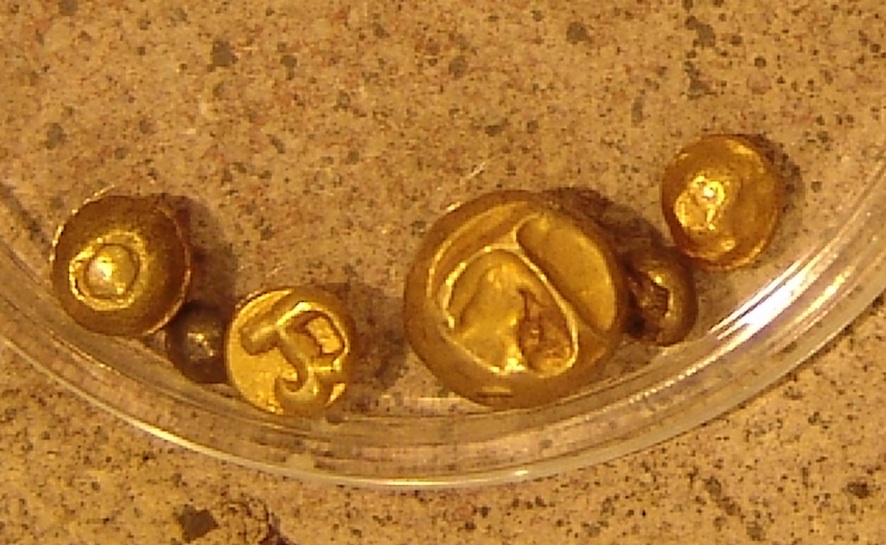 A collection of gold Piloncitos stamped with the Baybayin character for "Ma" possibly representing the nation of Ma-i. Arab chronicler Al Ya'akubi, had written that in the 800s, the kingdoms of Muja (Then Pagan/Hindu Brunei) and Mayd (Ma-i) militarily competed with the Chinese Empire.[62] Volume 186 of the official history of the Song dynasty describes the polity of Ma-i (c. before 971 – after 1339). Song dynasty traders visited Ma-i annually, and their accounts described Ma-i's geography, trade products, and the trade behaviors of its rulers.[103] Chinese merchants noted that Ma-i's citizens were honest and trustworthy.[104] Because the descriptions of Mai's location in these accounts are unclear, there is dispute about Mai's location, with some scholars believing it was located in Bay, Laguna,[13] and others believing it was on the island of Mindoro.[105] The Buddhist polity traded with Ryukyu and Japan.[106] Chao Jukua, a customs inspector in Fukien province, China wrote the Zhufan Zhi ("Description of the Barbarous Peoples").[107] William Henry Scott said, that unlike other Philippine kingdoms or polities which needed backing from the Chinese Imperial Court to attract commerce, the Polity of Ma-i was powerful enough to have no need to send tributes to the Chinese throne.[108] |
マイ 詳細は「マイ」を参照  「マ」を表すババイン文字が刻印された金のピロンシトのコレクション。おそらくマイ国民を表している。 アラブの年代記編纂者アル・ヤアコービは、800年代にムージャ王国(当時のパガン/ヒンドゥー教国ブルネイ)とメイド王国(マイ)が中国帝国と軍事的に 競合していたと記している。[62] 宋王朝の正史である『宋史』第186巻には、マイ(971年以前~1339年以降)の政治体制について記述されている。宋の貿易商は毎年マアイを訪れ、彼 らの記録にはマアイの地理、交易品、支配者の交易行動が記述されている。[103] 中国の商人たちは、マアイの市民は誠実で信頼できると記している。[104] これらの記録におけるマアイの位置の記述は不明瞭であるため、マアイの位置については論争があり、一部の学者はマアイはラグナ湾に位置していたと考えてい るが、[13] 他の学者はマアイはミンドロ島に位置していたと考えている いる。仏教政権は琉球や日本とも交易していた。[106] 中国の福建省の税関検査官であった趙汝魁は『諸番志』(「野蛮民族の記述」)を著した。[107] ウィリアム・ヘンリー・スコットは、他のフィリピンの王国や政体が中国皇帝の宮廷からの後援を必要としていたのに対し、マイの政体は強力であったため、 中国皇帝に貢物を送る必要がなかったと述べている。[108] |
| The nation of Sandao Main article: Sandao Sandao "三嶋" in Chinese characters, which was also known as Sanyu (三嶼), was a Prehispanic Filipino nation recorded in Chinese annals as a nation occupying the islands of Jiamayan 加麻延 (present-day Calamian), Balaoyou 巴姥酉 (present-day Palawan),[109] and Pulihuan 蒲裏喚 (near present-day Manila).[110] In the Chinese Gazetteer the Zhufan zhi 諸蕃志 (1225), it was described as a vassal-state of the more powerful nation of Ma-i centered in nearby Mindoro.[111] |
三嶼の国民 詳細は「三嶼」を参照 三嶼(サンユ)とも呼ばれた「三嶋」は、加麻延(現在のカラミアン)、巴姥酉(現在のパラワン)、[109] および蒲里喚(現在のマニラ近郊)の島々を占領する先史時代のフィリピン国民として、中国の年代記に記録されている。[110] 中国の 諸蕃志(1225年)という中国の地理誌では、より強力なマイ国民を中心とするミンドロ近郊の属国として記述されている。[111] |
| The nation of Pulilu Main article: Pulilu Pulilu was a Prehispanic polity centered at Polillo, Quezon[112] and was mentioned in the Chinese Gazeteer Zhufan zhi 諸蕃志 (1225). It is described as politically connected to the nation of Sandao "三嶋" at the Calamianes which itself was a vassal-state to the larger country of Ma-i "麻逸" centered in Mindoro. Its people were recorded to be warlike, and prone to pillaging and conflict. In this area, the sea is full of coral reefs, which have wavy surfaces that resemble decaying tree trunks or razor blades. Ships going by the reefs must be ready to make sharp maneuvers to avoid them because they are sharper than swords and halberds. Red coral and blue langgan coral are also produced here; however, they are quite difficult to find. It is also similar to the nation of Sandao in local customs and trade products. The chief export of this small polity are rare corals. |
プリル国民 詳細は「プリル」を参照 プリルは、ケソン州のポリロを中心とするスペイン到来以前の国家であり、中国の地理誌『諸蕃志』(1225年)にも言及されている。それは、ミンドロ島を 中心とする大きな国、マ・イ「麻逸」の属国であるカラミアン諸島の三嶋「Sandao」という国民と政治的に結びついていると記述されている。その国民は 好戦的で、略奪や紛争を起こしやすいと記録されている。この地域では、海はサンゴ礁でいっぱいであり、その表面は腐りかけた木の幹や剃刀の刃に似た波状の 模様がある。サンゴ礁のそばを通る船は、剣や槍よりも鋭いので、それらを避けるために機敏な操船が求められる。 赤サンゴや青ランガンサンゴもこの地域で産出されるが、それらを見つけるのはかなり難しい。 また、この地域はサンダオ国民の風習や貿易品とも類似している。 この小国家の主な輸出品は珍しいサンゴである。 |
| Visayan belligerence against Imperial China Writing in the 13th century, the Chinese historian Chao Ju-Kua mentioned raids conducted by the Pi-sho-ye on the port cities of southern China between A.D. 1174–1190, which he believed came by way of the southern portion of the island of Taiwan.[113] Subsequent historians identified these raiders as Visayans from the Visayas islands while the historian Efren B. Isorena, through analysis of historical accounts and wind currents in the Pacific side of East and Southeast Asia, concluded that said raiders were most likely the people of Ibabao (the precolonial name for the eastern coast and a portion of the northern coast of Samar).[114] |
ビサヤ人の好戦性と中国帝国 13世紀に著述した中国の歴史家、趙居誼は、西暦1174年から1190年の間に、ピショイ族が台湾島南部を経由して中国南部の港湾都市を襲撃したと述べ ている。[113] その後の歴史家たちは、これらの襲撃者をビサヤ諸島出身のビサヤ人であると特定したが、歴史家エフレン・B・イソレーナは、 歴史的記録と東アジアおよび東南アジアの太平洋側の風向を分析した結果、この襲撃者たちはサマール島東海岸および北部海岸の一部の植民地化以前の名称であ るイババオの人々である可能性が高いと結論づけた。[114] |
| Madja-as Main article: Madja-as 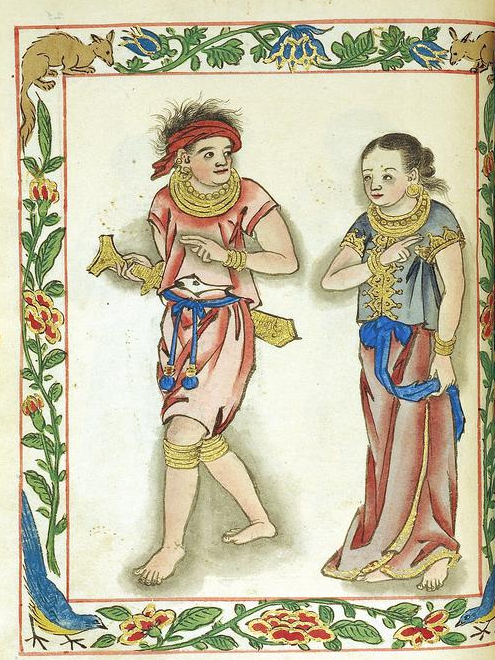 Images from the Boxer Codex illustrating an 1590's kadatuan or tumao (noble class) Visayan couple. 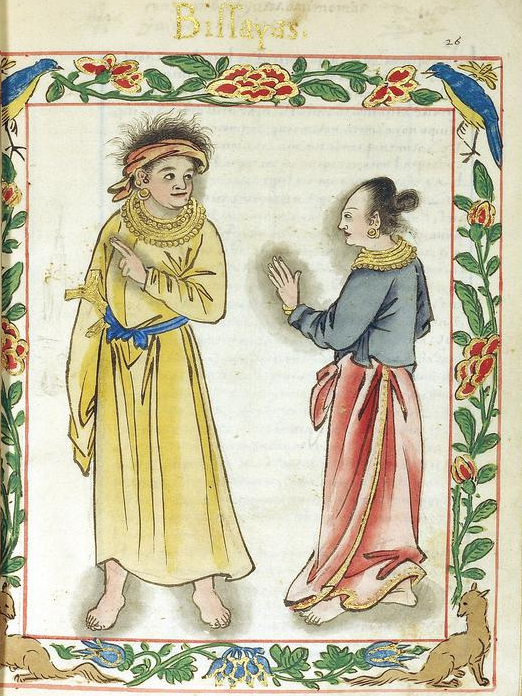 A royal couple of the Visayans. One theory espoused by some historians is that ten exiled datus of the collapsing empire of Srivijaya[115] led by Datu Puti migrated to the central islands of the Philippines, fleeing from Rajah Makatunaw of the island of Borneo. Upon reaching the island of Panay and purchasing the island from Negrito chieftain Marikudo, they established a confederation of polities and named it Madja-as and they settled the surrounding islands of the Visayas. This is according to Pedro Monetclaro's book Maragtas.[116][117][118] However, the actual personage of Rajah Makatunaw was mentioned in earlier Chinese texts about Brunei dating him to 1082, when he was the descendant of Seri Maharaja and he was accompanied by Sang Aji (the ancestor of Sultan Muhammad Shah). There is thus a disparity of dates between the Maragtas Book (based on oral legends) and the Chinese texts.[119] Historian Robert Nicholl also positively identify the pre-Islamic Bruneian Buddhist kingdom of Vijayapura, itself a Bornean tributary of the Srivijaya Empire in Palembang, and in earlier times was a rump state in Sarawak of the fallen Funan Civilization formerly at what is now Cambodia,[120]: 36 this was the ancestral homeland of the Visayans of the 10 Datus of Panay.[121] Furthermore, he identified the Rajah Makatunao mentioned in the Maragtas book with Rajah Tugau of the Melano nation centered in Sarawak. Augustinian Friar Rev. Fr. Santaren recorded that Datu Macatunao or Rajah Makatunao who was the "sultan of the Moros," and a relative of Datu Puti who seized the properties and riches of the ten datus was eventually killed by the warriors named Labaodungon and Paybare, using native Filipino and Bornean recruits. This, after learning of this injustice from their father-in-law Paiburong, sailed to Odtojan in Borneo where Makatunaw ruled. The warriors sacked the city, killed Makatunaw and his family, retrieved the stolen properties of the 10 datus, enslaved the remaining population of Odtojan, and sailed back to Panay. Labaw Donggon and his wife, Ojaytanayon, later settled in a place called Moroboro. Afterwards, the datus in Panay, other Visayan islands, and southern Luzon were said to have founded various towns.[122] |
マジャス 詳細は「マジャス」を参照  1590年代のカダトゥアンまたはトゥマオ(貴族階級)のビサヤ人カップルを描いた『ボクサー・コデックス』の挿絵。  ビサヤ人の王族のカップル。 一部の歴史家が唱える説によると、崩壊しつつあったシュリーヴィジャヤ帝国のダトゥ10人が、ダトゥ・プティに率いられて、ボルネオ島のラジャ・マカタナ ウから逃れ、フィリピン諸島の中央の島々へ移住したという。パナイ島に到着し、ネグリト族の族長マリクドから島を購入すると、彼らは政治連合を樹立し、そ れをマジャ=アスと名付け、ビサヤ諸島の周辺の島々に定住した。これは、ペドロ・モネクラロ著『マラガタ族』によるものである。[116][117] [118] しかし、実際のラジャ・マカタナウについては、1082年、セリ・マハラジャの子孫であり、サン・アジ(スルタン・ムハンマド・シャーの祖先)を伴ってい たとされる、ブルネイに関するより古い中国語の文献に言及されている。したがって、口頭伝承に基づく『マラガタス書』と中国語の文献の間には年代に食い違 いがある。[119] 歴史家のロバート・ニコルは、イスラム教以前のブルネイの仏教王国ビジャープラを、パレンバンにあるシュリーヴィジャヤ帝国のボルネオ属州であると特定し ている。また、それ以前には、現在のカンボジアにあたる場所にあったフナン文明の滅亡したサラワクの残存国家であったとも特定している。[120]: 36 これは、パナイの10人のダトゥ族の祖先の故郷である。[121] さらに、彼は『マラガタ族』に登場するマカタナオ王を、サラワクを中心とするメラノ国民のトゥガウ王と同一視した。アウグスティノ会の修道士であるサンタ レン神父は、マカトゥナオ首長またはマカトゥナオ王は「モロ族のスルタン」であり、10人の首長の財産と富を奪ったプティ首長の親戚であったが、最終的に はラバオドゥゴンとパイベレという名の戦士たちによって殺されたと記録している。義父のパイブロングからこの不正を知らされたラバオドンゴンとパイバレ は、マカタナウが統治するボルネオのオドトジャンへと船出した。戦士たちはその都市を略奪し、マカタナウとその家族を殺害し、10人のダトゥから盗まれた 財産を取り戻し、オドトジャンの残りの住民を奴隷にし、パナイ島へと船で戻った。ラバウ・ドンゴンと妻のオジャイタナヨンは、後にモロボロと呼ばれる場所 に移住した。その後、パナイ、ビサヤ諸島、ルソン島南部のダトゥたちは、さまざまな町を創設したと言われている。[122] |
| Cebu (historical polity) Main article: Cebu (historical polity) A picture of a Bronze Image of the Hindu God Shiva (lost during World War 2), found at Mactan-Cebu. It shows how the culture of the area was Hindu and Indianized. The Kingdom of Cebu was a precolonial state. It was founded by Sri Lumay otherwise known as Rajamuda Lumaya, a half-Malay and half-Indian, and was a minor prince of the Hindu Chola dynasty which happened to occupy Sumatra-Indonesia. He was sent by the maharajah to establish a base for expeditionary forces to subdue the local kingdoms but he rebelled and established his own independent Rajahnate instead. The Chinese recorded the name of the Rajahanate of Cebu as 'Sokbu' (束務) in Hokkien or 'Suwu' in Mandarin.[123] A kingdom of the same name as Suwu was mentioned to have existed as early as the year 1225, according to the Chinese Annals the Zhufan Zhi (諸蕃志)[124] and the later 17th Century Chinese traders to the Philippines referred to Cebu using the same term, it is thus presumed to be the same location.[123] The Indianized royalty of Cebu ruled the native Cebuano people from the Sanskrit/Tamil-labeled capital, Singhapala (சிங்கப்பூர்)y[125] which is Tamil-Sanskrit[126] for "Lion City", the same root words as with the modern city-state of Singapore. This rajahnate warred against the 'magalos' (slave traders) of Maguindanao and had an alliance with the Rajahnate of Butuan and Indianized Kutai in South Borneo, before it was weakened by the insurrection of Datu Lapulapu.[63] The kingdom enjoyed the diplomatic recognition of Thailand as observed by Ferdinand Magellan's expedition which noted an embassy borne by a ship from Siam (Thailand) that had landed at the Rajahnate and had tributes meant for Rajah Humabon.[127][128] |
セブ(歴史的政体) 詳細は「セブ(歴史的政体)」を参照 マクタン・セブで発見されたヒンドゥー教の神シヴァの青銅像(第二次世界大戦中に紛失)の写真。この地域の文化がヒンドゥー教であり、インド化されていたことを示している。 セブ王国は植民地化以前の国家であった。 セブ王国はスリ・ルマイ(別名ラジャムダ・ルマヤ)によって建国された。スリ・ルマイはマレー人とインディアンの混血であり、インドネシアのスマトラ島を 占領していたヒンドゥー教のチョーラ王朝の小国の王子であった。彼は遠征軍の基地を確立するためにマハラジャによって派遣されたが、反乱を起こし、代わり に独自のラジャ王朝を樹立した。中国人はセブ王国の名称を福建語で「Sokbu」(束務)または北京語で「Suwu」と記録している。[123] Suwuと同じ名称の王国は、1225年にはすでに存在していたことが、中国の年代記『諸蕃志』[124]に記載されている。また、17世紀のフィリピン への中国人貿易商も セブを同じ名称で呼んでいたことから、同じ場所であると推定されている。[123] セブのインディアン化された王族は、サンスクリット語/タミル語で「ライオンの都市」を意味するSinghapala(シンガポール)という首都から、先 住民であるセブアノ族を統治していた。 」という意味のタミル語とサンスクリット語の混成語であり、現在の都市国家シンガポールと同じ語源である。ラジャナテは、マギンダナオの「マガロス」(奴 隷商人)と戦い、ブトゥアンのラジャナテおよび南ボルネオのインディアン化されたクタイと同盟を結んでいたが、ダトゥ・ラプラプの反乱によって弱体化し た。[63] この王国は、フェルディナンド・マゼランの遠征隊が観察したように、タイから船で送られた大使がラジャナテに上陸し、ラジャ・フマボンに貢ぎ物をしたとい う記録が残っているように、タイから外交的な承認を受けていた。ラジャナートに上陸し、ラジャ・フマボン宛ての貢ぎ物を携えていた。[127][128] |
| Butuan Main article: Butuan (historical polity) 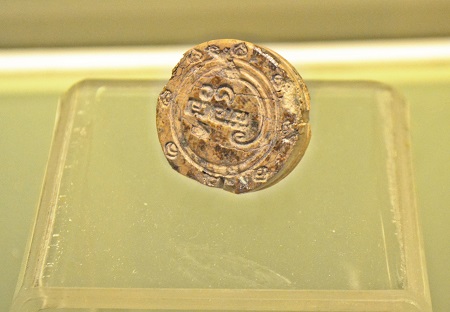 The Butuan Ivory Seal, displayed at the National Museum of the Philippines. The Kawi script lettering says "But-wan" and the smaller lettering (similar to Baybayin) says "Bu-wa" (diacritics for the "Wan/Ban" in Kawi and "Bu/Ba" in the smaller letters have worn off). The official history of the Song dynasty next refers to the Rajahnate of Butuan (c. before 1001–1756) in northeastern Mindanao which is the first polity from the Philippine archipelago recorded as having sent a tribute mission to the Chinese empire—on March 17, 1001, CE. Butuan later attained prominence under the rule of Rajah Sri Bata Shaja.[129] In the year 1011, Rajah Sri Bata Shaja, the monarch of the Indianized Rajahnate of Butuan, a maritime-state famous for its goldwork[130] sent a trade envoy under ambassador Likan-shieh to the Chinese Imperial Court demanding equal diplomatic status with other states.[131] The request being approved, it opened up direct commercial links with the Rajahnate of Butuan and the Chinese Empire thereby diminishing the monopoly on Chinese trade previously enjoyed by their rivals, Tondo and the Champa civilization.[132] Evidence of the existence of this rajahnate is given by the Butuan Silver Paleograph.[133] Researcher Eric Casino, believes the name of the first Rajah mentioned in Chinese records, Rajah Kiling, is not Visayan in origin but rather, Indian, because Kiling refers to the people of India.[134] The Sejarah Melayu (Malay Annals) of the nearby country of Malaysia, refers to the similarly worded Keling as immigrant people from India.[135] |
ブトゥアン 詳細は「ブトゥアン(歴史的ポリティ)」を参照  フィリピン国立博物館に展示されているブトゥアン象牙印章。カウィ文字の文字は「ブトゥワン」と表記され、より小さな文字(バヤバインに類似)は「ブワ」 と表記されている(カウィ文字の「ワン/バン」と、より小さな文字の「ブ/バ」のダイアクリティカルマークは摩耗している)。 宋の公式の歴史書では、ミンダナオ島北東部のブトゥアン・ラジャ(1001年頃~1756年)が、フィリピン諸島から中国帝国に朝貢使節団を送った最初の 国家として記録されている。ブトゥアンは後にラジャ・スリ・バタ・シャジャの統治下で隆盛を極めた。[129] 1011年、インド化されたブトゥアンのラジャナートの君主であるラジャ・スリ・バタ・シャジャは、金細工で有名な海洋国家であったが[130]、他の国 家と同等の外交的地位を要求して、リカン・シェ大使を中国皇帝の宮廷に派遣した。この要請が承認されると、 ブトゥアン王国と中国帝国との直接的な商業関係が確立され、それによってそれまでライバルであったトンダ王国とチャンパ文明が独占していた中国貿易の独占 が弱まった。[132] このブトゥアン王国の存在を示す証拠は、ブトゥアン銀古文書によって示されている。[133] 研究者のエリック・カジノは、中国側の記録に最初に登場するラジャの名前であるラジャ・キリンは、ビサヤ語ではなく、むしろインディアン語であると考えて いる。なぜなら、Kilingはインドの人々を指すからである。[134] 隣国マレーシアの『マレー史』では、同様の語であるKelingをインドからの移民の人々として言及している。[135] |
| Sanmalan Main article: Sanmalan 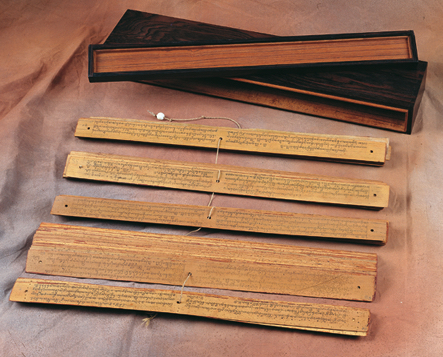 The Nagarakretagama, chronicled the rise of the Java-centered Majapahit Empire and its conquest of the kingdom of Solot (Sulu), which then rebelled and sacked the Majapahit province of Pon-i (Brunei). At the same time as the rise of Butuan was the emergence of Sanmalan. Sanmalan was a precolonial Philippine kingdom on what is now Zamboanga.[136] Known in Chinese records as "Sanmalan" 三麻蘭. The Chinese chronicled during 982, a tribute from its Rajah or King, Chulan, represented at the imperial court by ambassador Ali Bakti.[137] In the 1200s, the Chinese chronicle Zhufan zhi (諸蕃志) recorded its change from a trade emporium to slaving state as Zamboanga began waging war and raiding its neighboring kingdoms in Borneo, Philippines, Sulawesi, and Ternate; for slaves to sell in Java.[111] Influence of the Madjapahit onto the Philippines During the 1300s, the Chinese annals, Nanhai zhi, reported that Brunei invaded or administered Sarawak and Sabah as well as the Philippine kingdoms of Butuan, Sulu and Ma-i (Mindoro) which would regain their independence at a later date.[138] Afterwards, the Javanese-centered Hindu empire of Majapahit, in turn invaded Brunei and had briefly ruled the Sulu Archipelago as recorded in the epic poem Nagarakretagama, which stated that they controlled Solot (Sulu).[139] Eventually, Sulu reestablished independence, and in vengeance, assaulted the Majapahit province of Poni (Brunei) before a fleet from the capital drove them out.[140][141] According to Javanese records a Javanese force expelled Sulu marauders from Brunei during the reign of Angka Wijaya who was the last king to reign over Majapahit. The inhabitants of the Soeloe Islands (in the present Philippines) made an attack against Brunei (in order to obtain camphor), in keeping with their (piratical) nature, but they were driven off by the Javanese soldiers. — Stamford Raffles Sulu reaction against Majapahit Imperialism didn't stop with the sacking of Poni (Brunei) as Sulu also invaded North and East Kalimantan in Borneo, which were former Majapahit territories.[142] The subsequent start of the Islamic era ushered the slow death of Majapahit as its provinces eventually seceded and became independent sultanates. With the upsurge of Islam, the remnants of Hindu Majapahit eventually fled to the island of Bali.[143] In Luzon, citing Kapampangan oral legends, Nick Joaquin wrote about a princess of Namayan named Sasaban who married the Emperor of Majapahit, locally known as Soledan and is allegedly the Maharajah Anka Widyaya.[144] |
サンマラン 詳細は「サンマラン」を参照  ナガラクレットガマは、ジャワを中心としたマジャパイト帝国の勃興とソロット王国(スールー)の征服を記録している。その後、ソロット王国は反乱を起こし、マジャパイトのポンイ州(ブルネイ)を略奪した。 ブトゥアンの台頭と同時に、サンマランが出現した。サンマランは、現在のザンボアンガにあった植民地化前のフィリピン王国である。[136] 中国の記録では「サンマラン」三麻蘭として知られている。982年の中国の年代記には、ラジャまたは王であるチュランが、大使のアリ・バクティを皇帝の宮 廷に派遣したことが記録されている。[137] 1200年代には、中国の年代記『諸蕃志』に、貿易の中心地から奴隷貿易の拠点へと変化したことが記録されている。これは、サンボアンガがボルネオ、フィ リピン、スラウェシ、テルナテの近隣諸国に戦争を仕掛け、襲撃を始めたためである。 。奴隷をジャワで売るためである。[111] マジャパイトのフィリピンへの影響 1300年代、中国の年代記『南海志』は、ブルネイがサラワクとサバ、およびブトゥアン、スールー、マイ(ミンドロ)といったフィリピンの王国を侵略また は支配下に置き、それらの王国は後に独立を取り戻したと伝えている。[138] その後、ジャワを中心としたヒンドゥー帝国マジャパヒトがブルネイを侵略し、スールー諸島を短期間支配した 叙事詩『ナガラクテガマ』に記録されているように、ソロト(スールー)を支配下に置いたと述べている。[139] 最終的にスールーは再び独立を回復し、首都からの艦隊が彼らを追い出す前に、復讐としてマジャパヒトのポニ(ブルネイ)を襲撃した。[140][141] ジャワの記録によると、マジャパイト最後の王アンガ・ウィジャヤの治世下で、ジャワ軍がブルネイからスールーの略奪者を追放した。スールー諸島(現在の フィリピン)の住民は、(海賊的な)性質にふさわしく、ブルネイを攻撃し(樟脳を得るために)、しかしジャワの兵士たちによって追い払われた。 — スタンフォード・ラッフルズ スールーのマジャパイト帝国主義に対する反応は、ポニ(ブルネイ)の略奪で終わることはなく、スールーはボルネオの北カリマンタンと東カリマンタンにも侵 攻した。これらはかつてマジャパイトの領土であった。[142] その後、イスラム教の時代が始まり、マジャパイトは徐々に衰退し、その地方は最終的に独立したスルタン国となった。イスラム教の台頭により、ヒンドゥー教 マジャパイト王国の残党は最終的にバリ島へと逃れた。 ルソン島では、カパンパンガン族の口承伝説を引用して、ニック・ホアキンがナマヤン王女ササバンがマジャパイト王(地元ではソレダンとして知られる)と結婚し、マハラジャ・アンカ・ウィディアとなったと書いた。 |
The Sultanate of Sulu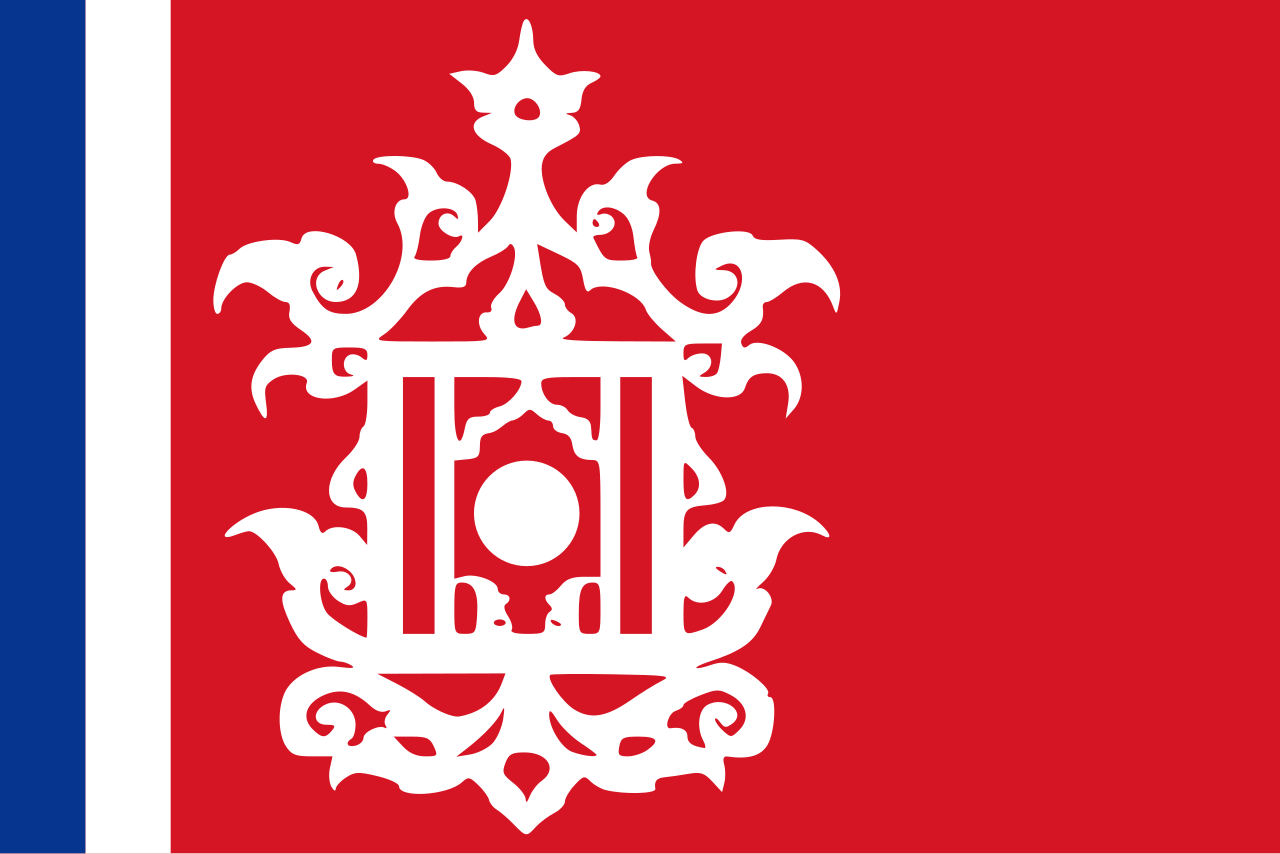 The banner of the Sultanate of Sulu Main article: Sultanate of Sulu In 1380, Karim ul' Makdum and Shari'ful Hashem Syed Abu Bakr, an Arab trader born in Johore, Malaysia; arrived in Sulu from Malacca and established the Sultanate of Sulu by converting its previous ruler, the Hindu king, Rajah Baguinda, to Islam and then marrying his daughter. This sultanate eventually gained great wealth due to its diving for fine pearls.[145] Before Islamization, the then Rajahnate of Sulu was established by Visayan speaking Hindu migrants from the Rajahnate of Butuan to the Sulu Archipelago as Tausug, the language of the Sulu state is classified as a Southern Visayan language.[146] During the 10th-13th centuries the Champa civilization, located in Central Vietnam and the port-kingdom of Sulu traded with each other which resulted in Cham merchants settling in Sulu where they were known as Orang Dampuan . The Orang Dampuan were slaughtered by envious native Sulu Buranuns due to the wealth of the Orang Dampuan.[147] The Buranun were then subjected to retaliatory slaughter by the Orang Dampuan. Harmonious commerce between Sulu and the Orang Dampuan was later restored and the Orang Dampuans became the ancestors of the local Yakan people.[148] The Yakans were descendants of the Taguima-based Orang Dampuan who came to Sulu from Champa.[149] As told before, Sulu was also briefly ruled under the Hindu Majapahit empire as narrated in the Nagarakretagama but afterwards, Sulu rebelled and sacked Brunei which was a nearby loyal province of Majapahit as Sulu extended its conquest to the former Majapahit territory of East and North Kalimantan. However, with the onset of Islam by the 15th century, they associated themselves with their new Arab-descended sultans whose origins was in Malacca and their fellow co-religionist Moros (ethnic groups of the Philippine who had accepted Islam) than their still Hindu, Visayan-speaking cousins. This culminated with royal intermarriages between the families of the then newly Islamized Maynila, as well the Sultanates of Brunei, Sulu and Malacca.[150] |
スールー王国 スールー王国の旗 詳細は「スールー王国」を参照 1380年、マレーシアのジョホール生まれのアラブ人商人カリーム・ウル・マクドゥームとシャリーフル・ハシェム・サイード・アブ・バクルがマラッカから スールーに到着し、それまでの支配者であったヒンドゥー教徒のラジャ・バギンダをイスラム教に改宗させ、その娘と結婚することでスールー王国を建国した。 このスルタン国は、良質の真珠の採取により、やがて莫大な富を得るようになった。[145] イスラム化以前、スールー諸島にブトゥアン・ラジャナートからビサヤ語を話すヒンドゥー教徒が移住し、スールー諸島国家の言語であるタウスグ語は南ビサヤ 語に分類されるようになった。[146] 10世紀から13世紀にかけて、ベトナム中部に位置するチャンパ文明と 中央ベトナムとスールーの港王国は互いに交易を行い、その結果、チャム人の商人たちがスールーに定住し、オラン・ダンプアンとして知られるようになった。 オラン・ダンプアンは、彼らの富をねたんだスールーの原住民であるブラナン人によって虐殺された。[147] その後、ブラナン人はオラン・ダンプアンによる報復的な虐殺の対象となった。スールーとオラン・ダンプアン間の調和の取れた交易は後に回復し、オラン・ダ ンプアンは地元のヤカン族の祖先となった。[148] ヤカン族は、チャムパからスールーにやってきたタギマを拠点とするオラン・ダンプアンの子孫である。[149] 前述の通り、スールーはナガラクレタグマに語られているように、ヒンドゥー教のマジャパイト帝国の支配下に一時的に置かれたが、その後、スールーは反旗を 翻し、 スールーは、かつてのマジャパイトの領土であった東カリマンタンと北カリマンタンに征服を拡大し、マジャパイトの忠実な属州であったブルネイを略奪した。 しかし、15世紀にイスラム教が伝来すると、彼らは、マジャパイトよりも、マラッカを起源とするアラブ人の子孫である新たなスルタンや、同じイスラム教徒 であるモロ人(イスラム教を受け入れたフィリピンの民族)と関係を築くようになった。これは、当時新たにイスラム教に改宗したマニラの家族と、ブルネイ、 スールー、マラッカのスルタン家との王族間の婚姻関係に集約された。[150] |
| The Sultanate of Maguindanao Main article: Sultanate of Maguindanao The Sultanate of Maguindanao rose to prominence at the end of the 15th century or the beginning of the 16th century, Shariff Mohammed Kabungsuwan of Johor, Malaysia: introduced Islam in the island of Mindanao and he subsequently married Paramisuli, an Iranun princess from Mindanao, and established the Sultanate of Maguindanao.[151] It ruled most parts of coastal Mindanao and continued to exist prior to the Spanish colonialization until the 19th century. The Sultanate also traded and maintained good relations with the Chinese, Dutch, and the British.[152][153] Confederate States of Lanao 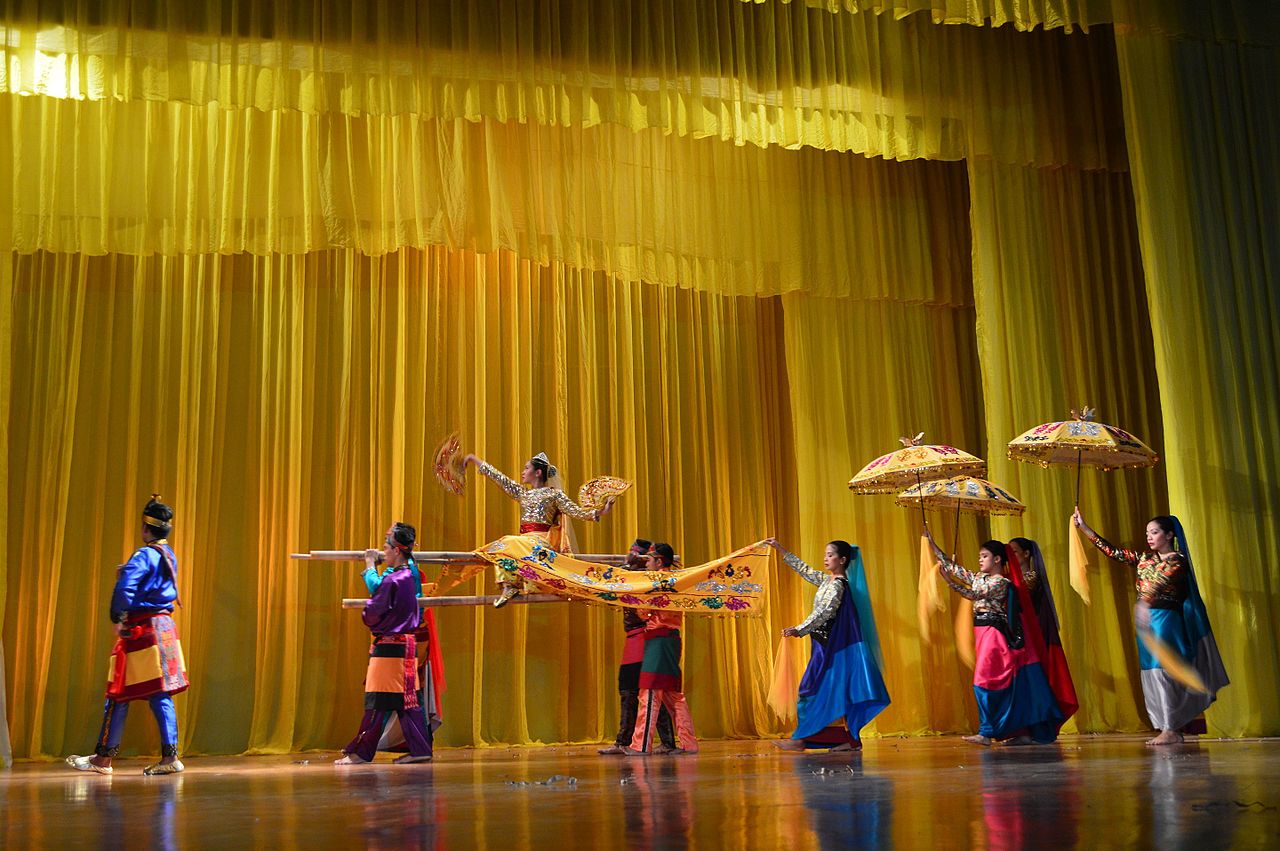 A performance of the Maranao royal dance, the "Singkil". Main article: Confederate States of Lanao The Sultanates of Lanao in Mindanao, Philippines were founded in the 16th century through the influence of Shariff Kabungsuan, who was enthroned as first Sultan of Maguindanao in 1515. Islam was introduced to the area by Muslim missionaries and traders from the Middle East, Indian and Malay regions who propagated Islam to Sulu and Maguindanao. Unlike in Sulu and Maguindanao, the Sultanate system in Lanao was uniquely decentralized. The area was divided into Four Principalities of Lanao or the Pat a Pangampong a Ranao which are composed of a number of royal houses (Sapolo ago Nem a Panoroganan or The Sixteen (16) Royal Houses) with specific territorial jurisdictions within mainland Mindanao. This decentralized structure of royal power in Lanao was adopted by the founders, and maintained up to the present day, in recognition of the shared power and prestige of the ruling clans in the area, emphasizing the values of unity of the nation (kaiisaisa o bangsa), patronage (kaseselai) and fraternity (kapapagaria). By the 16th century, Islam had spread to other parts of the Visayas and Luzon. |
マギンダナオ・スルタン国 詳細は「マギンダナオ・スルタン国」を参照 マギンダナオ・スルタン国は15世紀末から16世紀初頭にかけて台頭した。マレーシアのジョホールのシャリフ・モハメッド・カブンスワンがミンダナオ島にイスラム教を導入し、その後ミンダナオのイラヌ族の王女パラミスリと結婚し、マギンダナオ・スルタン国を建国した。 それはミンダナオ島の沿岸部の大部分を支配し、スペインによる植民地化が始まる前の19世紀まで存続した。スルタン国は中国人、オランダ人、イギリス人とも交易を行い、良好な関係を維持していた。 ラナオ連合州  マラナオ族の王族舞踊「シンキル」のパフォーマンス。 詳細は:ラナオ連合州 フィリピン、ミンダナオ島のラナオ・スルタン国は、1515年にマギンダナオ初代スルタンとして即位したシャリフ・カブンスアン(Shariff Kabungsuan)の影響により、16世紀に建国された。イスラム教は、イスラム教宣教師や中東、インディアン、マレー地域からの商人により、スー ルーやマギンダナオに広められた。スールーやマギンダナオとは異なり、ラナオのスルタン制は独特な分散型であった。この地域は、ラナオの4つの主要な領 地、またはパタ・パンガンポン・ラナオ(Pat a Pangampong a Ranao)に分割され、ミンダナオ本土内の特定の管轄区域を持つ複数の王族(サポロ・アゴ・ネマ・パノログナンまたは16の王族(The Sixteen (16) Royal Houses)で構成されていた。ラナオにおけるこの分散型の王権構造は、その地域の支配一族が共有する権力と威信を認識し、国民の団結 (kaiisaisa o bangsa)、庇護(kaseselai)、同胞愛(kapapagaria)の価値を強調するものとして、建国者たちによって採用され、今日まで維持 されてきた。16世紀までに、イスラム教はビサヤ諸島とルソン島の他の地域にも広がっていた。 |
| The Bruneian Empire and the expansion of Islam Territorial extent of the Bruneian Empire Main article: Bruneian Empire Upon the secession of Poni (Brunei) from the Majapahit Empire, they imported the Arab Emir from Mecca, Sharif Ali, and became an independent Sultanate. During the reign of his descendant, Sultan Bolkiah, in 1485 to 1521, he married Laila Menchanai, the daughter of Sulu Sultan Amir Ul-Ombra to expand Brunei's influence in both Luzon and Mindanao. Eventually, Rajah Salalila of Maynila married the daughter of Sultan Bolkiah and Puteri Laila Menchanai of Sulu, placing Maynila under the influence of Brunei.[154] The new dynasty under the Islamized Rajah Salalila was established to challenge the House of Lakandula in Tondo.[155][156] Furthermore, Islam was further strengthened by the arrival to the Philippines of traders and proselytizers from Malaysia and Indonesia. The invasion of Brunei spread Chinese royalty such as Ong Sum Ping's kin and companions plus Arab dynasties such as the clan of Sultan Sharif Ali and allies to the Philippines.[157] Brunei was so powerful that it already subjugated their Hindu Bornean neighbor, Kutai, to the south, though Kutai survived through a desperate alliance with Hindu Butuan and Cebu which were already struggling against encroaching Islamic powers like Maguindanao. Brunei had also gained influence over the northern third and the southern third of the Philippines.[158][159][160][161][162][163][164][165] Sultan Bolkiah is associated with the legend of Nakhoda Ragam the singing captain, a myth about a handsome, virile, strong, musically gifted and angelic voiced prince who is known for his martial exploits. There is contextual evidence that Sultan Bolkiah may indeed be Nakhoda Ragam, since he is of half Visayan-Filipino descent since later Spanish accounts record that Filipinos, especially Visayans, were obsessed with singing and the warrior castes were particularly known for their great singing abilities.[166] |
ブルネイ帝国とイスラム教の拡大 ブルネイ帝国の領土 詳細はブルネイ帝国を参照 ポニ(ブルネイ)がマジャパイト帝国から離脱すると、彼らはメッカからアラブ首長シャリフ・アリを輸入し、独立したスルタン国となった。彼の末裔であるス ルタン・ボルキアの治世下、1485年から1521年の間、ボルキアはスールー・スルタン・アミール・ウル・オンブラの娘ライラ・メンチャナイと結婚し、 ルソン島とミンダナオ島の両方でブルネイの影響力を拡大した。最終的に、マニラのラジャ・サラリラはスル王国のスルタン・ボルキアとプテリ・ライラ・メン チャナイの娘と結婚し、マニラはブルネイの影響下に入った。[154] イスラム教に改宗したラジャ・サラリラの新しい王朝は、トンドのラカンダラ家に対抗するために樹立された。[155][156] さらに、マレーシアやインドネシアから来た商人や布教者がフィリピンに到着したことで、イスラム教はさらに強固なものとなった。ブルネイの侵略により、オ ング・サム・ピンの親族や仲間たちといった中国の王族、およびシャリフ・アリ・スルタン一族やその同盟者といったアラブの王族がフィリピンに広がった。 [157] ブルネイは非常に強力であったため、すでに南のヒンドゥー教徒のボルネオ人居住区クタイを服従させていた。クタイは、すでにマギンダナオのようなイスラム 勢力の侵攻に抵抗していたヒンドゥー教徒のブトゥアンやセブと必死に同盟を結んで生き延びていたが、 。ブルネイはまた、フィリピンの北部3分の1と南部3分の1にも影響力を及ぼしていた。[158][159][160][161][162][163] [164][165] スルタン・ボルキアは、歌う船長ナホダ・ラガムの伝説と関連付けられている。この伝説は、ハンサムで、たくましく、力強く、音楽の才能に恵まれ、天使のよ うな歌声を持つ王子が武勇伝で知られているという神話である。スルタン・ボルキアがナホダ・ラガムである可能性を示す文脈上の証拠がある。なぜなら、彼は ビサヤ系フィリピン人の血を引くハーフであり、後のスペインの記録によると、フィリピン人、特にビサヤ人は歌に夢中になっており、戦士階級は特に優れた歌 唱力で知られていたからである。[166] |
| The Lucoes Main article: Lucoes 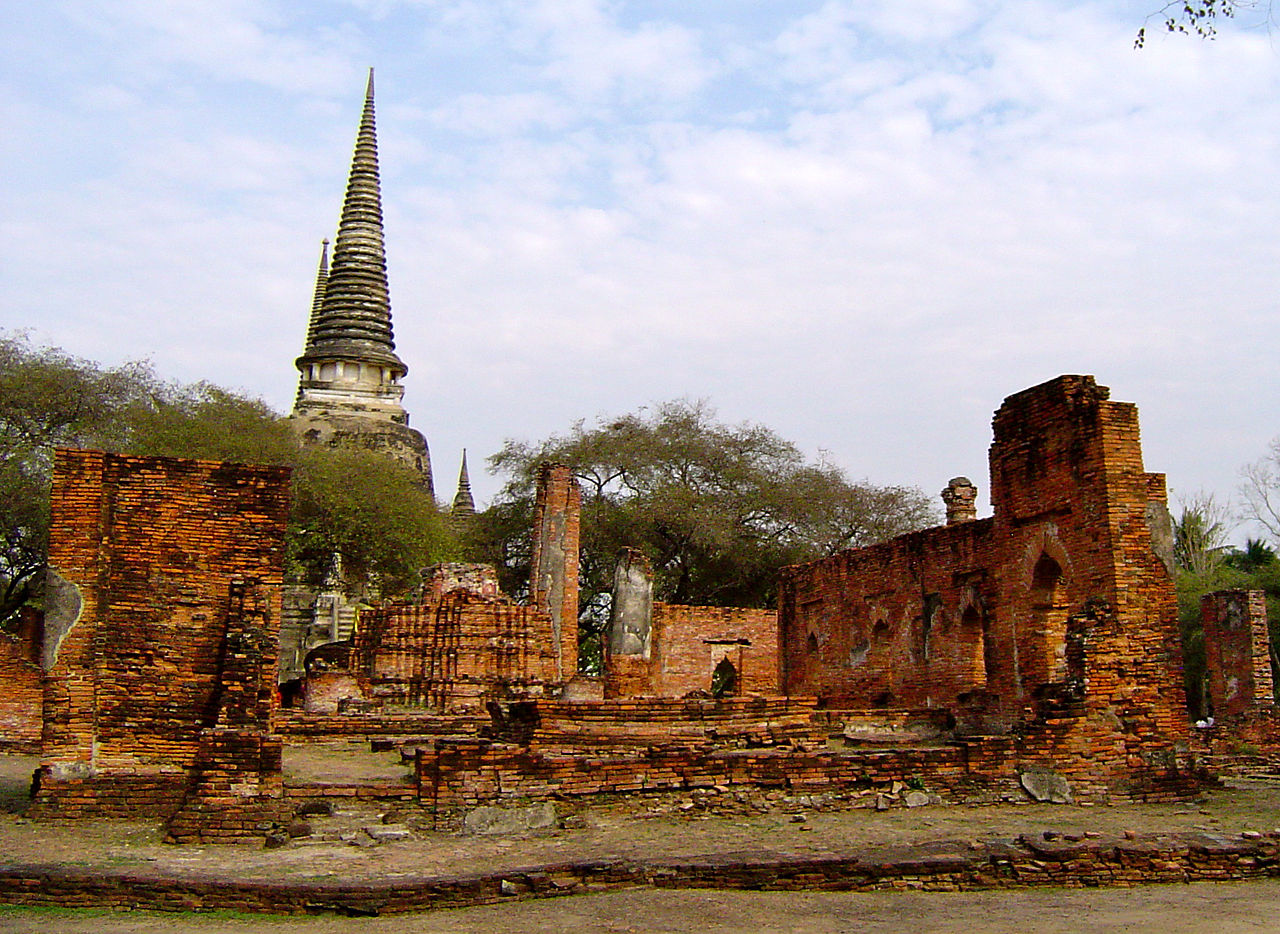 Ruins of the Royal Palace of Ayutthaya, in the Ayutthaya Historical Park. Ayutthaya (Thailand) was the setting of the Burmese-Siamese Wars where Lucoes from Luzon, Philippines were used as soldiers by both sides. Concurrent with the spread of Islam in the Philippine archipelago was the rise of the Lucoes, or Luzones, who were the people of Luzon. They rose to prominence by establishing overseas communities all across Southeast Asia as well as maintaining relations with South and East Asia, participating in trading ventures, navigation expeditions and military campaigns in Burma,[167] Lucoes warriors aided the Burmese king in his invasion of Siam in 1547. At the same time, Lusung warriors fought alongside the Siamese king and faced the same Burmese Army.[168] They were also in Japan, Brunei, Malacca, East Timor and Sri Lanka[169][20] where they were employed as traders and mercenaries.[170][64][171] One prominent Luções was Regimo de Raja, who was a spice magnate and a Temenggung (Jawi: تمڠݢوڠ)[172] (Governor and Chief General) in Portuguese Malacca. He was also the head of an international armada which traded and protected commerce between the Indian Ocean, the Strait of Malacca, the South China Sea,[173] and the medieval maritime principalities of the Philippines.[16] Pinto noted that there were a number of Luzones in the Islamic fleets that went to battle with the Portuguese in the Philippines during the 16th century. The Sultan of Aceh together with the Ottoman commander Heredim Mafamede whose uncle was the Viceroy of Egypt, assigned Luzones to defend Aceh, and gave one of them, Sapetu Diraja, the task of holding Aru (northeast Sumatra) in 1540. Pinto also says one was named leader of the Malays remaining in the Moluccas Islands after the Portuguese conquest in 1511.[174] Pigafetta notes that one of them was in command of the Brunei fleet in 1521.[20] However, the Luzones did not only fight on the side of the Muslims. Pinto says they were also apparently among the natives of the Philippines who fought the Muslims in 1538.[174] The Luzones were also pioneer seafarers, and it is recorded that the Portuguese were not only witnesses but also direct beneficiaries of Lusung's involvement. Many Luzones chose Malacca as their base of operations because of its strategic importance. When the Portuguese finally took Malacca in 1512, the resident Luzones held important government posts in the former sultanate. They were also large-scale exporters and ship owners that regularly sent junks to China, Brunei, Sumatra, Siam and Sunda. One Lusung official by the name of Surya Diraja annually sent 175 tons of pepper to China and had to pay the Portuguese 9000 cruzados in gold to retain his plantation. His ships became part of the first Portuguese fleet that paid an official visit to the Chinese empire in 1517.[175] On Mainland Southeast Asia, Luzones aided the Burmese king in his invasion of Siam in 1547. At the same time, Luzones fought alongside the Siamese king and faced the same elephant army of the Burmese king in the defence of the Siamese capital at Ayuthaya.[168] Lucoes military and trade activity reached as far as Sri Lanka in the Indian Subcontinent where Lungshanoid pottery made in Luzon were discovered in burials.[176] The Portuguese were soon relying on Luzones bureaucrats for the administration of Malacca and on Luzones warriors, ships and pilots for their military and commercial ventures in East Asia. It was through the Luzones who regularly sent ships to China that the Portuguese discovered the ports of Canton in 1514. And it was on Luzones ships that the Portuguese were able to send their first diplomatic mission to China 1517. The Portuguese had the Luzones to thank for when they finally established their base at Macao in the mid-1500s.[170] The Luzones were also instrumental in guiding Portuguese ships to discover Japan. The Western world first heard of Japan through the Portuguese. But it was through the Luzones that the Portuguese had their first encounter with the Japanese. The Portuguese king commissioned his subjects to get good pilots that could guide them beyond the seas of China and Malacca. In 1540, the Portuguese king's factor in Brunei, Brás Baião, recommended to his king the employment of Lusung pilots because of their reputation as "discoverers."[177] Thus it was through Luzones navigators that Portuguese ships found their way to Japan in 1543. The Luzones so impressed the Portuguese soldier, Joao de Barros, he considered the Luzones who were militarily and commercially active across the region, "the most warlike and valiant of these parts."[178] Filipinos from the island of Luzon (Lucoes) were not the only Filipinos abroad, historian William Henry Scott, quoting the Portuguese manuscript Summa Orientalis, noted that Mottama in Burma (Myanmar) had a large presence of merchants from the island of Mindanao.[179] |
ルソ族 詳細は「ルソ族」を参照  アユタヤ歴史公園内にあるアユタヤ王宮跡。アユタヤ(タイ)は、ビルマ・シャム戦争の舞台であり、フィリピン・ルソン島のルソ族が双方の軍に兵士として徴用された。 フィリピン列島におけるイスラム教の広がりと同時に、ルソン人(Luzones)であるルソン人(Luzones)が台頭した。彼らは東南アジア全域に海 外コミュニティを確立し、南アジアや東アジアとの関係を維持し、貿易事業や航海探検、ビルマでの軍事作戦に参加することで、その名を広く知られるように なった。1547年には、ルソン人の戦士たちがビルマ王のシャム侵攻を支援した。同時に、ルソン人の戦士たちはシャム王とともに戦い、同じビルマ軍と対峙 した。[168] 彼らはまた、日本、ブルネイ、マラッカ、東ティモール、スリランカにもいた。[169][20] 彼らはそこで貿易業者や傭兵として雇われていた。[170][64][171] 著名なルソン人の一人に、香辛料王にしてポルトガル領マラッカのテンメンガン(ジャウィ語 。彼はまた、ポルトガル領マラッカの総督兼最高司令官であり、香辛料王でもあった。彼はまた、インディアン洋、マラッカ海峡、南シナ海、フィリピンの中世 の海洋公国間の貿易と商業保護を担う国際艦隊の司令官でもあった。 ピントは、16世紀にフィリピンでポルトガルと戦ったイスラム艦隊には多数のルソン人がいたと指摘している。アチェのスルタンは、叔父がエジプト総督で あったオスマン帝国の司令官ヘレディム・マファメデとともに、アチェの防衛にルソン人を任命し、そのうちの一人であるサペトゥ・ディラジャにアルー(北東 スマトラ)の統治を任せるなどした。ピントはまた、1511年のポルトガルによる征服の後、モルッカ諸島に残ったマレー人のリーダーの一人がいたとも述べ ている。[174] ピガフェッタは、1521年に彼らの一人がブルネイ艦隊の指揮を執っていたと記している。[20] しかし、ルソン人はイスラム教徒の側で戦っていただけではない。ピントによると、彼らは1538年にイスラム教徒と戦ったフィリピン先住民の一派でもあったようだ。 ルソン家は開拓航海者でもあり、ポルトガル人はルソン家の関与の証人であるだけでなく、直接的な受益者でもあったことが記録されている。多くのルソン家の 人々は、マラッカの戦略的重要性から、マラッカを活動拠点としていた。1512年にポルトガルがマラッカを最終的に占領した際、マラッカに居住していたル ソン家の人々は、かつてのスルタン国の政府で重要な役職に就いていた。彼らはまた、大規模な輸出業者であり船主でもあり、ジャンク船を中国、ブルネイ、ス マトラ、シャム、スンダ諸島に定期的に派遣していた。ルソン人の役人であるスルヤ・ディラジャは、毎年175トンのコショウを中国に送り、プランテーショ ンを維持するためにポルトガルに9000クルザードの金を支払っていた。彼の船団は、1517年に中国帝国に公式訪問した最初のポルトガル艦隊の一部と なった。[175] 東南アジア大陸部では、1547年にルソン人がビルマ王のシャム侵攻を支援した。同時に、ルソン人はシャムの王とともに戦い、シャムの首都アユタヤの防衛 において、ビルマ王の象軍団と対峙した。[168] ルソン人の軍事活動と貿易活動は、インディアン亜大陸のスリランカにまで達し、ルソン島で製造されたルンガナイド陶器が埋葬地で発見された。[176] ポルトガル人は、マラッカの統治にはルソン人の官僚を、東アジアでの軍事および商業事業にはルソン人の戦士、船、水先案内人を頼りにするようになった。 ポルトガル人が1514年に広州の港を発見したのは、ルソン人が定期的に中国に船を送っていたからである。そして、ポルトガル人が1517年に中国に最初 の外交使節団を送ることができたのは、ルソン人の船のおかげであった。ポルトガル人が1500年代半ばにようやくマカオに拠点を確立できたのも、ルソン人 のおかげであった。 ルソン人は、ポルトガル船が日本を発見する手助けもした。西洋世界が初めて日本について耳にしたのはポルトガル人を通じてだった。しかし、ポルトガル人が 初めて日本人と遭遇したのは、ルソン人を通じてだった。ポルトガル王は、中国やマラッカの海を越えて航海できる優秀な水先案内人を集めるよう臣下に命じ た。1540年、ブルネイにいたポルトガル王の代理人ブラス・バイアンは、彼らの「発見者」としての評判から、ルソン人の水先案内人の雇用を王に進言し た。[177] こうして、1543年にポルトガル船が日本への航路を見つけたのは、ルソン人の航海士たちのおかげであった。ルソン人はポルトガル人兵士のジョアン・デ・ バロスに強い印象を与え、彼はその地域で軍事的にも商業的にも活躍していたルソン人について、「この地域で最も好戦的で勇敢な人々」と評した。[178] 海外在住のフィリピン人はルソン島(ルソン人)出身者だけではない。歴史学者ウィリアム・ヘンリー・スコットは、ポルトガル語の原稿『Summa Orientalis』を引用し、ビルマ(ミャンマー)のモッタマにはミンダナオ島出身の商人が多く存在していたと指摘している。ミンダナオ島出身の商人 が多く住んでいたと指摘している。[179] |
| Rise and fall of Bo-ol Main article: Bo-ol Around 1563, at the closing stages of the precolonial era, the Bo-ol achieved prominence and it was known to a later Spanish missionary, Alcina, as the "Venice of the Visayas", because it was a wealthy, wooden and floating city-state in the Visayas. However, this kingdom was eventually attacked and destroyed by soldiers from the Sultanate of Ternate, a state made up of Muslim Moluccans. The survivors of the destruction, led by their datu, Pagbuaya, migrated to northern Mindanao and established a new settlement in the region known as Dapitan. 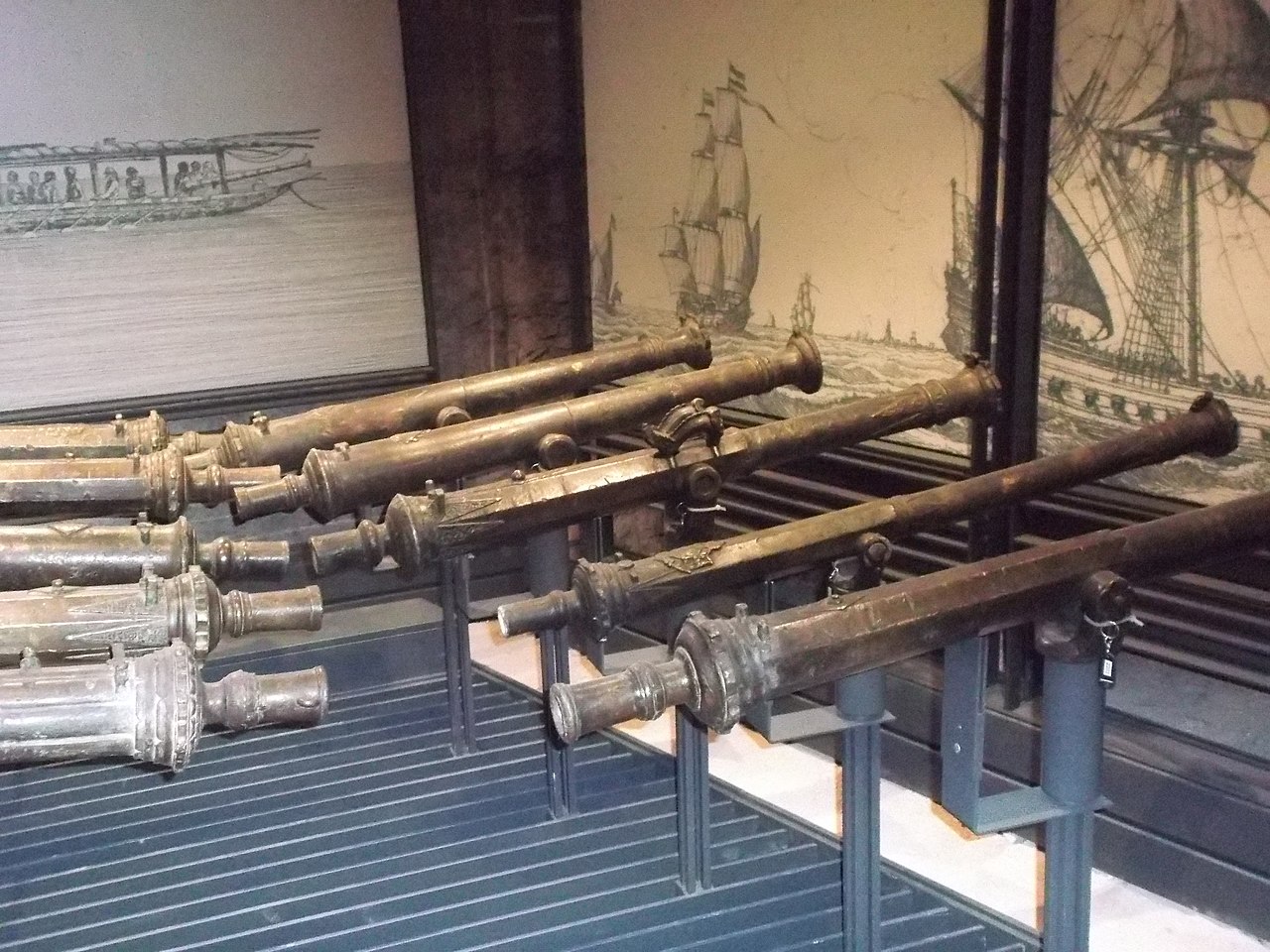 A collection of Philippine lantaka, a type of swivel-gun used in inter-kingdom wars. They then waged war against the Sultanate of Lanao and settled in the lands conquered from them. Eventually, in vengeance against the Muslims and Portuguese allied to the Ternateans, they aided the Spanish in the conquest of Muslim Manila and in the Spanish expeditions to capture Portuguese Ternate. Inter-kingdom rivalries During this period there was also a simmering territorial conflict between the polity of Tondo and Maynila, to which the ruler of Maynila, Rajah Matanda, sought military assistance against Tondo from his relatives at the Sultanate of Brunei.[180] The Hindu Rajahnates of Butuan and Cebu also endured slave raids from, and waged wars against the Sultanate of Maguindanao.[181] Simultaneous with these slave-raids, was the rebellion of Datu Lapulapu of Mactan against Rajah Humabon of Cebu.[182] The population was sparse due to warfare and also due to the common frequency of typhoons and the Philippines' location on the Pacific ring of fire.[183] The multiple states competing over the limited territory and people of the islands simplified Spanish colonialization by allowing its conquistadors to effectively employ a strategy of divide and conquer for rapid conquest. |
ボオル王国の興亡 詳細は「ボオル王国」を参照 1563年頃、スペイン人が到来する前の時代末期に、ボオル王国は隆盛を極め、後にスペイン人宣教師アルシーナによって「ビサヤ諸島のヴェニス」として知 られるようになった。しかし、この王国は最終的にイスラム教徒のモルッカ人によって構成された国家、テルナテのスルタン国の兵士たちによって攻撃され、滅 ぼされた。 滅亡の生き残りたちは、ダトゥのパグバヤに率いられ、ミンダナオ島北部に移住し、ダピタンとして知られる地域に新たな集落を築いた。  フィリピン・ランタカの集合体。これは、王国間の戦争で使用された旋回銃の一種である。 その後、彼らはラナオ・スルタン国と戦争し、彼らから奪った土地に定住した。最終的に、テルナテ人と手を組んだイスラム教徒とポルトガル人への復讐とし て、彼らはスペインによるイスラム教徒のマニラ征服と、ポルトガル領のテルナテ島を占領するためのスペインの遠征を支援した。 王国間の対立 この期間中、トンダとマイニラの政治体制の間では、くすぶる領土紛争も起こっていた。マイニラの支配者ラジャ・マタンダは、ブルネイのスルタン国に親戚が いることを理由に、トンダに対する軍事支援を求めた。[180] ブトゥアンとセブのヒンドゥー教徒のラジャ、マギンダナオのスルタン国に対して奴隷襲撃を耐え、戦争を仕掛けた。[181] これらの奴隷狩りと同時期に、セブのラジャ・フマボンに対してマクタンのダトゥ・ラプラプが反乱を起こした。[182] 人口は戦争と、台風が頻繁に発生すること、フィリピンが環太平洋火山帯に位置していることによっても減少した。[183] 限られた領土と島民を巡って複数の国家が争っていたため、スペインによる植民地化は単純化され、征服者たちは「分断して統治せよ」戦略を効果的に用いて、 迅速に征服することができた 迅速な征服を可能にした。 |
| https://en.wikipedia.org/wiki/History_of_the_Philippines |
リ ンク
文 献
そ の他の情報
Copyleft,
CC, Mitzub'ixi Quq Chi'j, 1996-2099
Copyleft, CC, Mitzub'ixi Quq Chi'j, 1996-2099
☆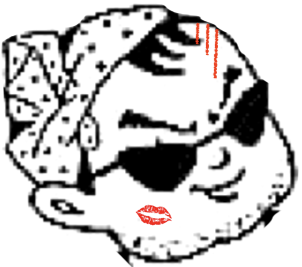
 ☆
☆